One of the most daunting things when I first started looking for a gun was…what size bullet to get?
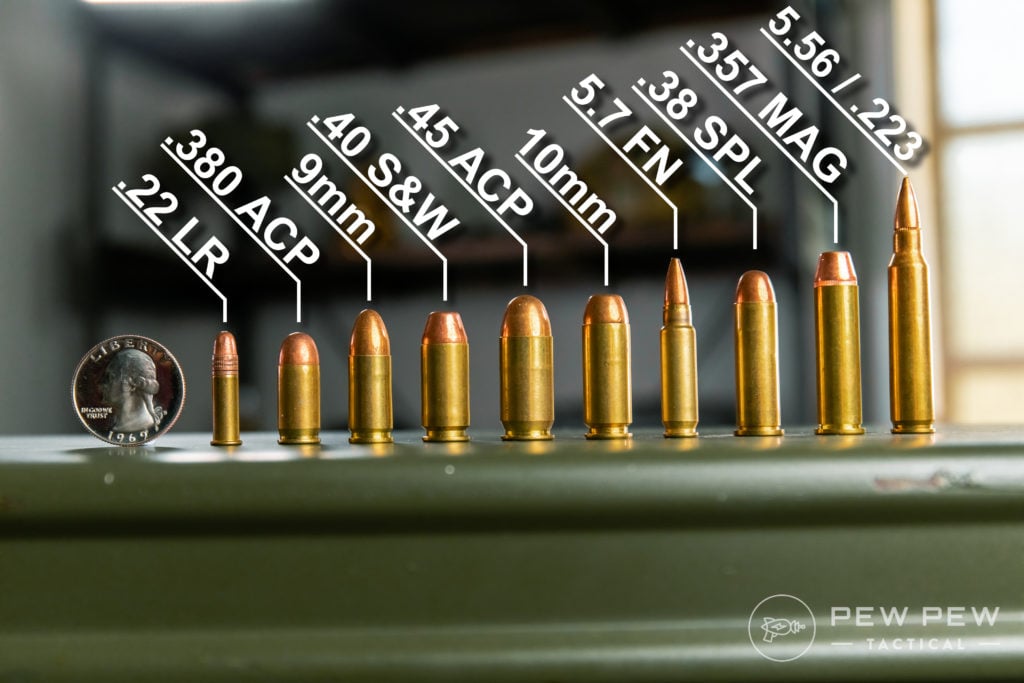
Things got even crazier when I started to look at rifles…
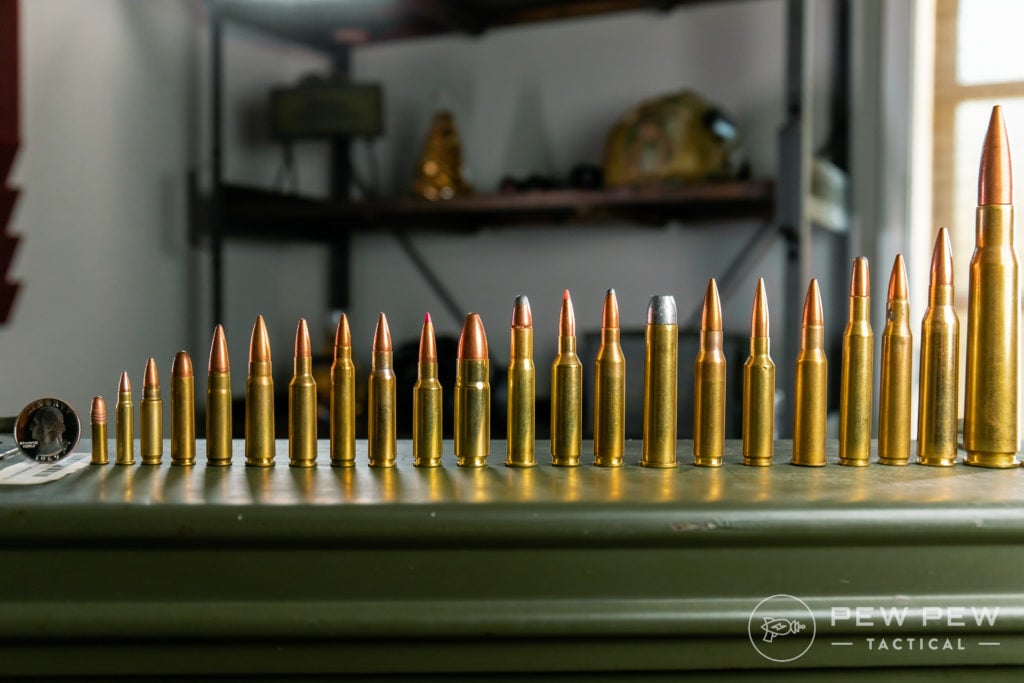
But don’t worry…we’ll be covering some of the most popular handgun, rifle, and shotgun calibers out there.
As well as the benefits and weaknesses of each.
Then we’ll follow up with some bullet terminology and the different types of bullet tips (hollow point, etc), how shotgun shell sizes work, and a breakdown of the components of a round.
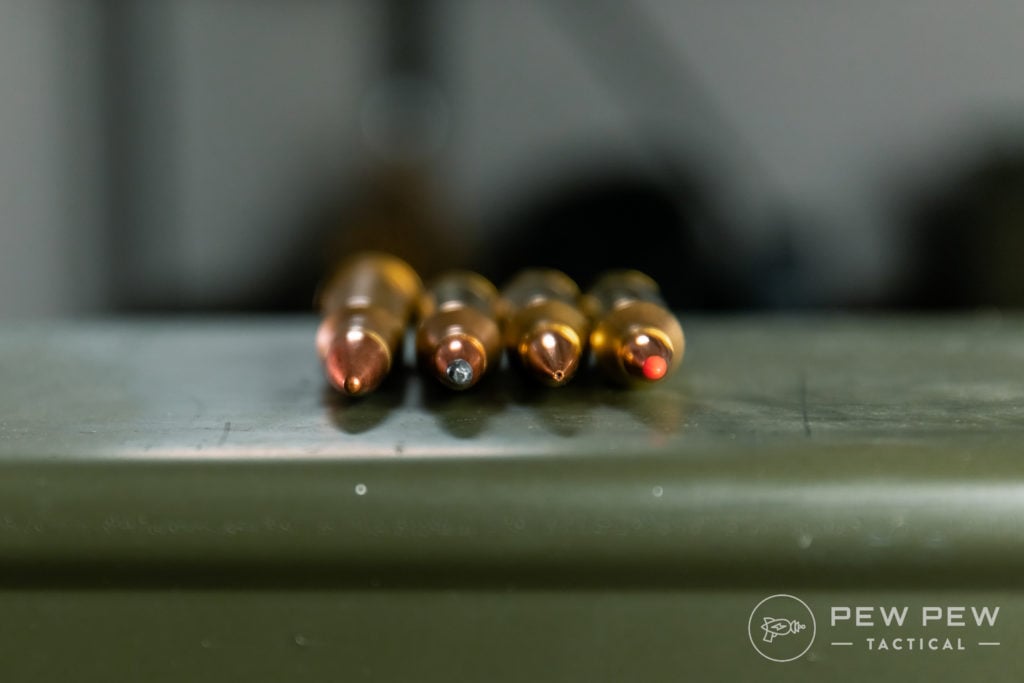
By the end, you’ll be a bullet pro!
Table of Contents
Loading...
Bullet Size & Caliber
First!
For guns, “caliber” means the diameter of the barrel and thus the diameter of the bullet that is going through it. Usually in inches or mm.
Also for terminology’s sake, “bullet” just means the metal projectile, while the entire thing is called a cartridge.
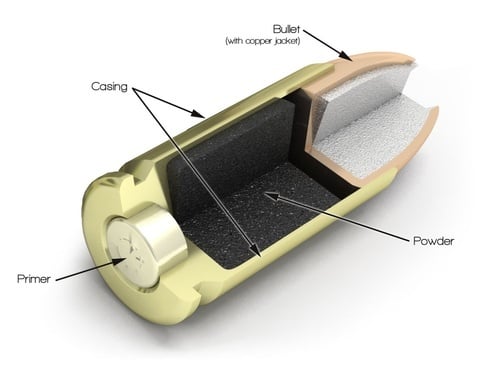
Here are some common 9mm bullets.
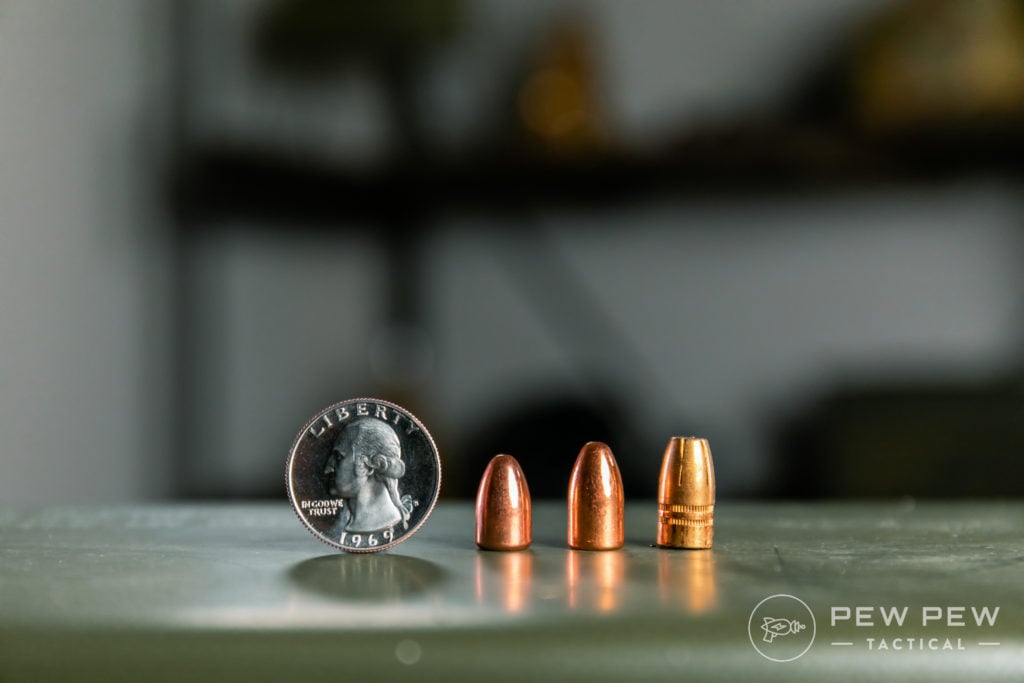
If you want to jump ahead, check out our suggestion for the Best Places to Buy Ammo Online.
Now what you’ve been waiting for…
Rimfire vs. Centerfire
The first differentiator is between rimfire and centerfire cartridges.
The rimfire’s primer is built into the rim while the centerfire cartridge has the primer in the center. Pro tip…if you can see a circle in the middle…it’s a centerfire cartridge.
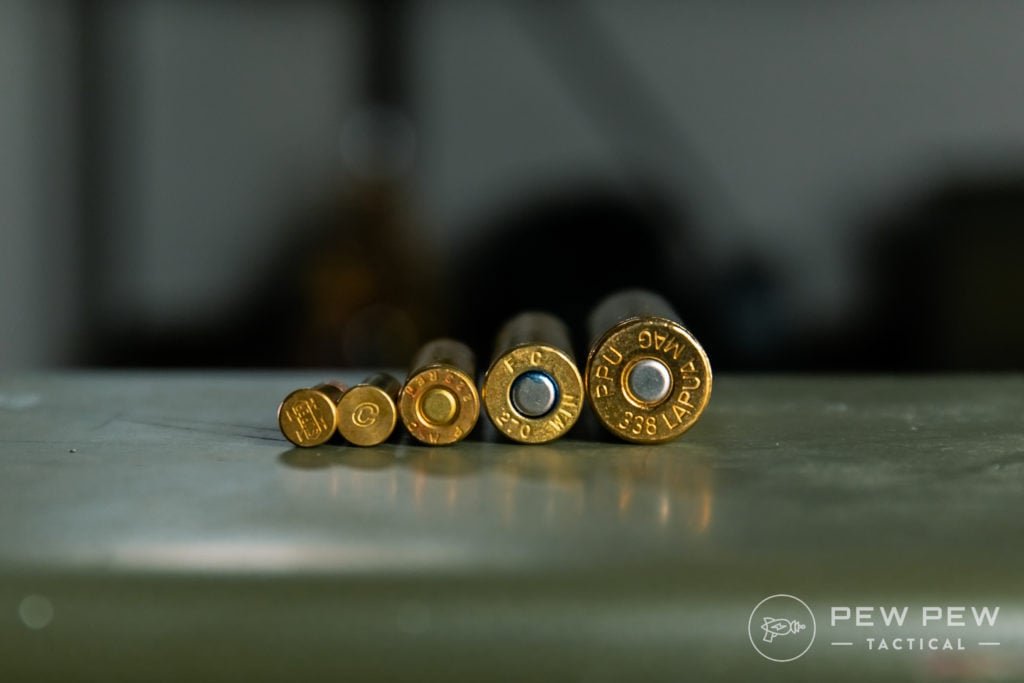
Rimfires are extremely cheap (a few cents each) and the .22 LR is the most popular rimfire caliber.
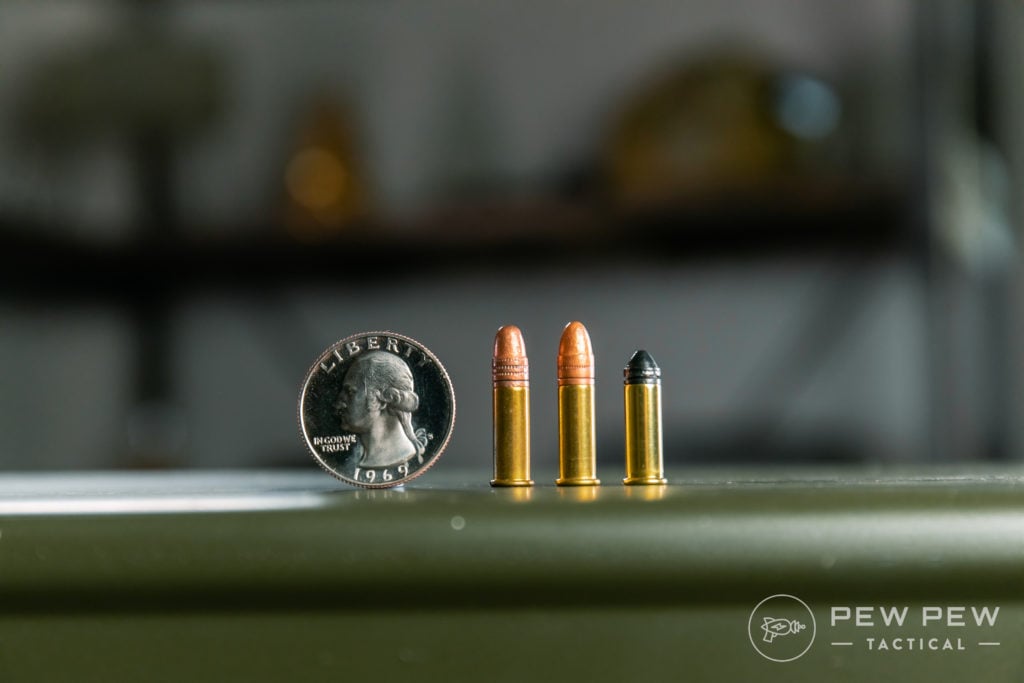
This animation shows how the firing pin hits the primer in a cartridge.
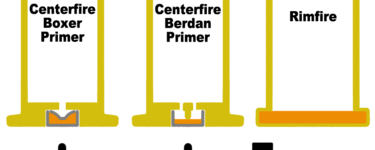
Here are some expended casings from a rimfire vs centerfire.
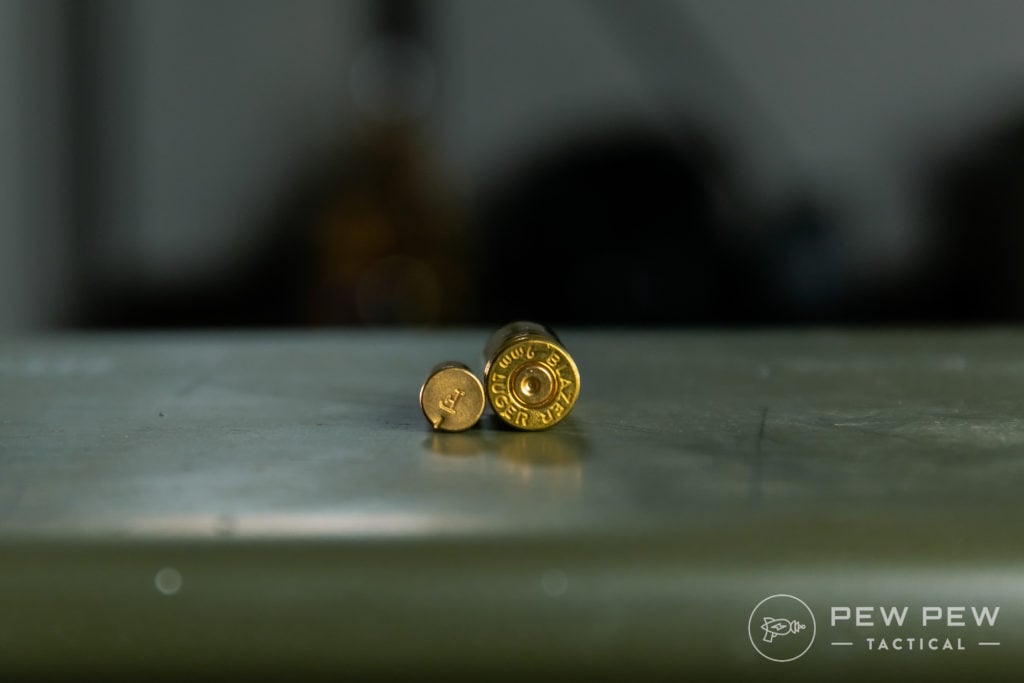
For even more differences, see our article on Rimfire Ammo or familiarize yourself with How Guns Work.
Common Bullet Calibers
To make things a little more confusing, there’s a mixture of measurements in inches and millimeters.
There’s also a unit of weight called a “grain” which is used to denote the weight of bullets and gunpowder. A “grain” is really small since 7,000 grains make up one pound.
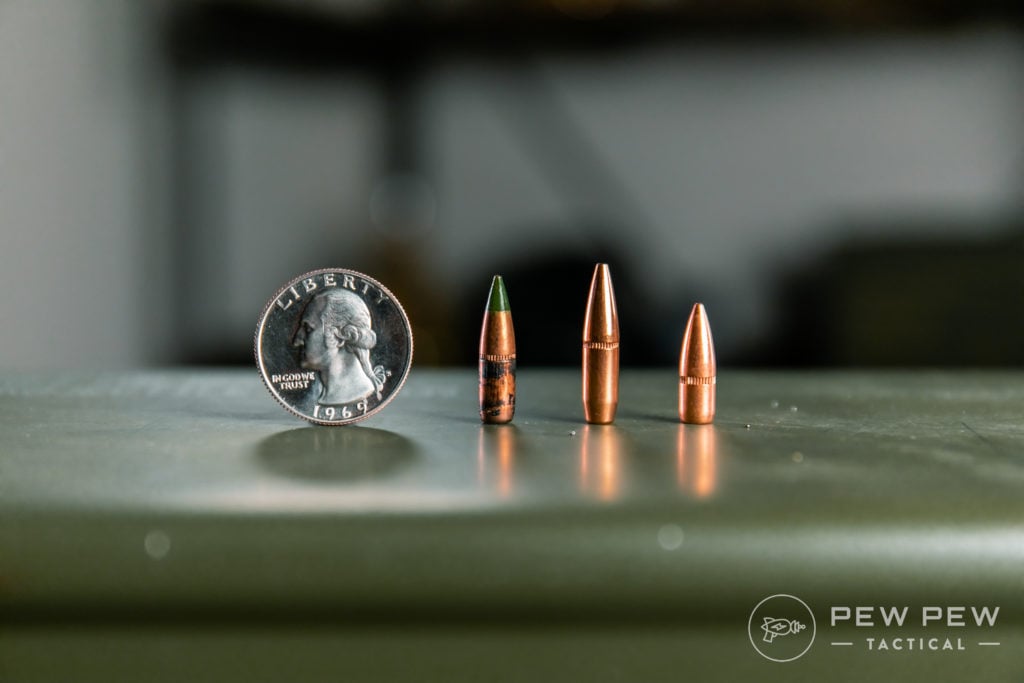
Now let’s go through some!
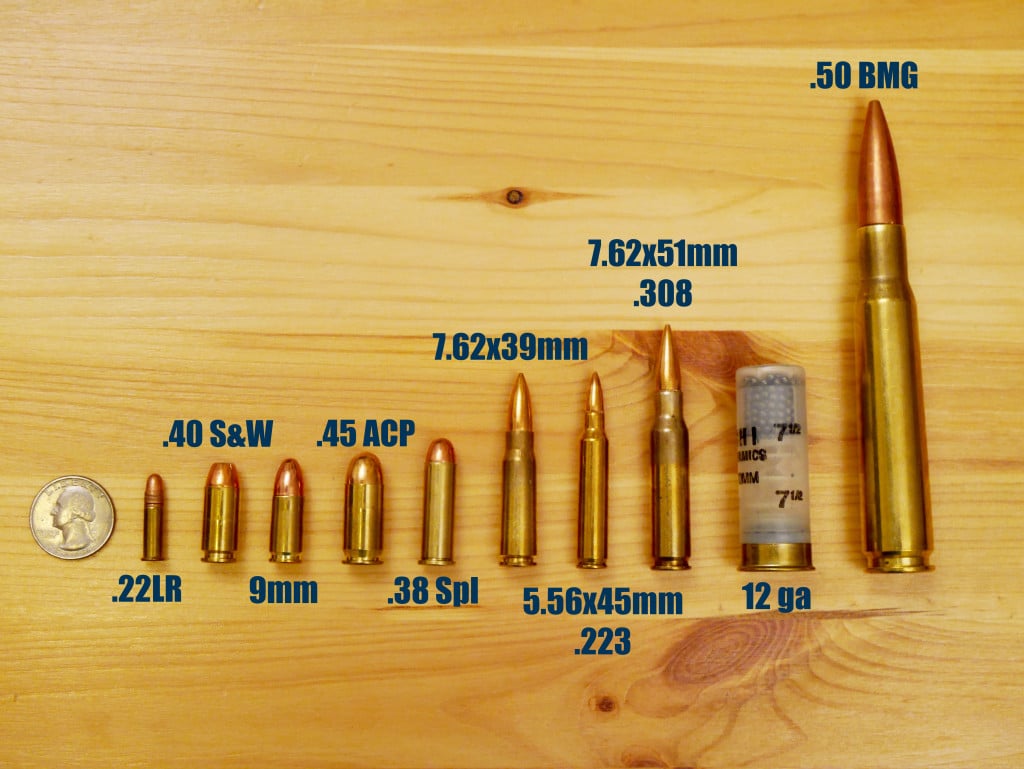
.22 LR
The “twenty-two” long rifle is the most common caliber in terms of units sold.
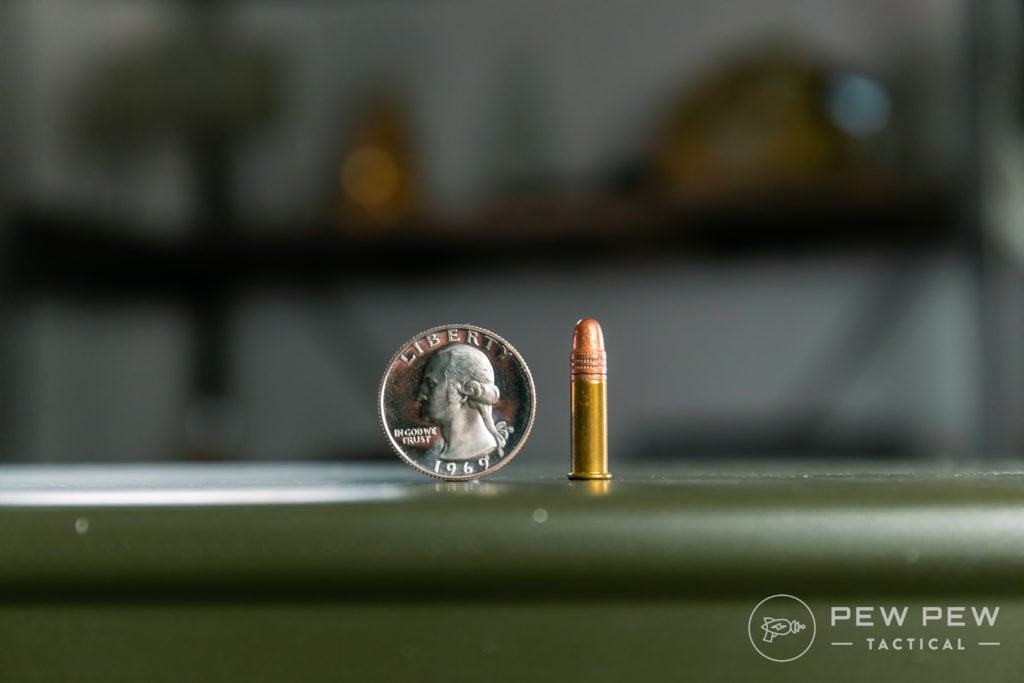
It has a bullet weight of around 30 to 40 grains and is extremely mild shooting in both pistols and rifles.
The recoil is almost non-existent, which makes it a great starter round for someone who has never shot a gun or is uncomfortable with the noise.
The low price of the bullets is also great for learning sight pictures.
It is traditionally the starting caliber for shooters. These things are only a few steps up from a pellet gun round…especially in a rifle (Ruger 10/22) shown below.
They’re mostly for taking care of rats, snakes, and birds. They’ll be useful for self-defense, but it might take a shot or six.
For more info:
.380 ACP
Now we’re getting into slightly beefier sizes.
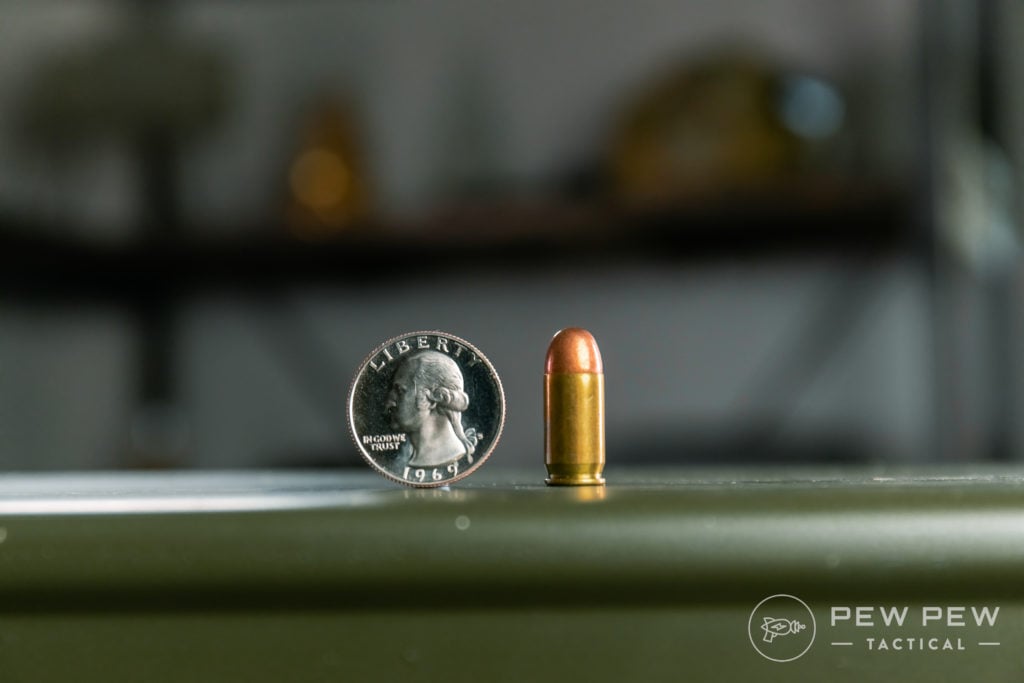
Personally, I would never use a gun with anything smaller than a .380 as my primary carry weapon.
Sometimes called a “9mm Short”, it has seen a major boost in popularity recently thanks to the various “pocket pistols” that have come on the market.
This bullet has relatively low recoil and, at close range, good penetration.
Gun author Massad Ayoob once said of the .380, “Some experts will say it’s barely adequate, and others will say it’s barely inadequate.” This is a low-power round.
Because of the nature of the bullet and the guns that shoot it, it’s going to be relatively useless beyond close-ish range.
For more info:
9mm
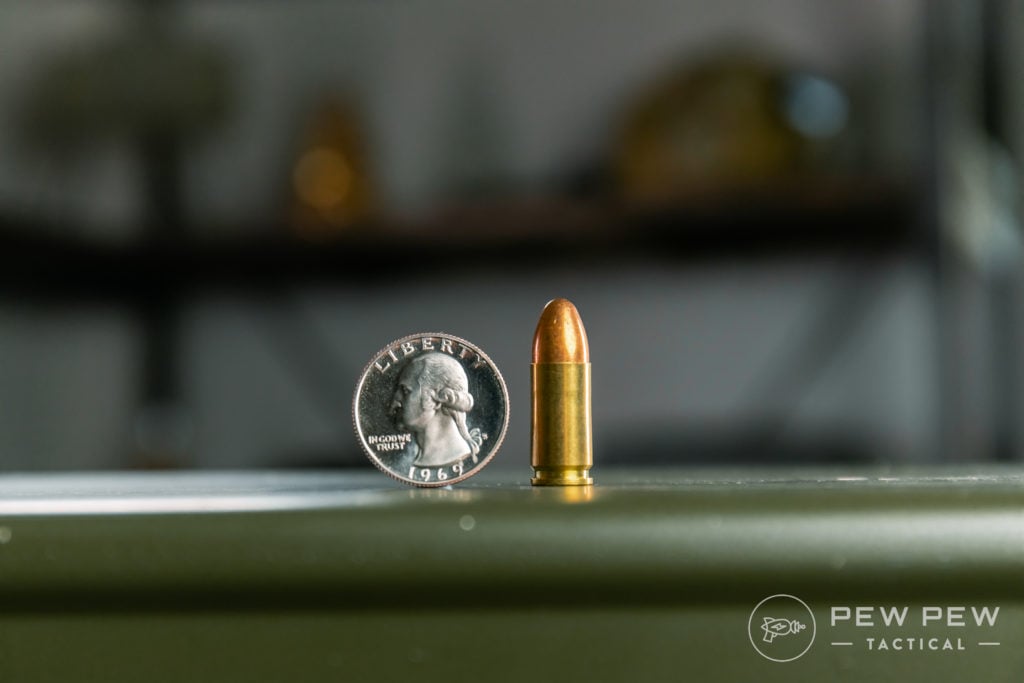
This pistol round is officially known as the “9x19mm Parabellum” or “9mm Luger” to distinguish it from other 9mm rounds. But you will be fine just saying “nine millimeter” or “nine mil” for those in the know.
9mm is my personal favorite, and if there was a “Goldilocks” round, this would be it.
The very first gun I bought was a 9mm.
They’re fun at the range. They’re good for defense.
Believe it or not…or actually believe it because it’s true…the 9mm bullet is the same diameter as the bullet used in the .380 and the .38 Special.
The difference between the three is the amount of gunpowder behind it and possibly bullet weight.

It is the standard round for NATO countries and the majority of police forces around the world.
It is mild shooting, can vary in weight from 115 to 147 grains, and has varying stopping power based on the type of bullet (hint, go with hollow points).
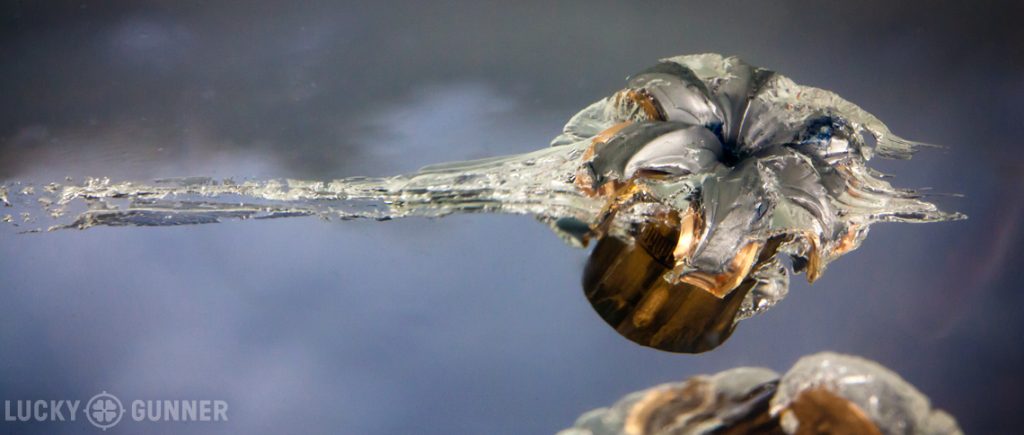
Many, many guns use this size as well. A compact 9mm gun can be used for concealed carry. Most of the guns that use this size can hold on average 15 to 17 rounds in the magazine.
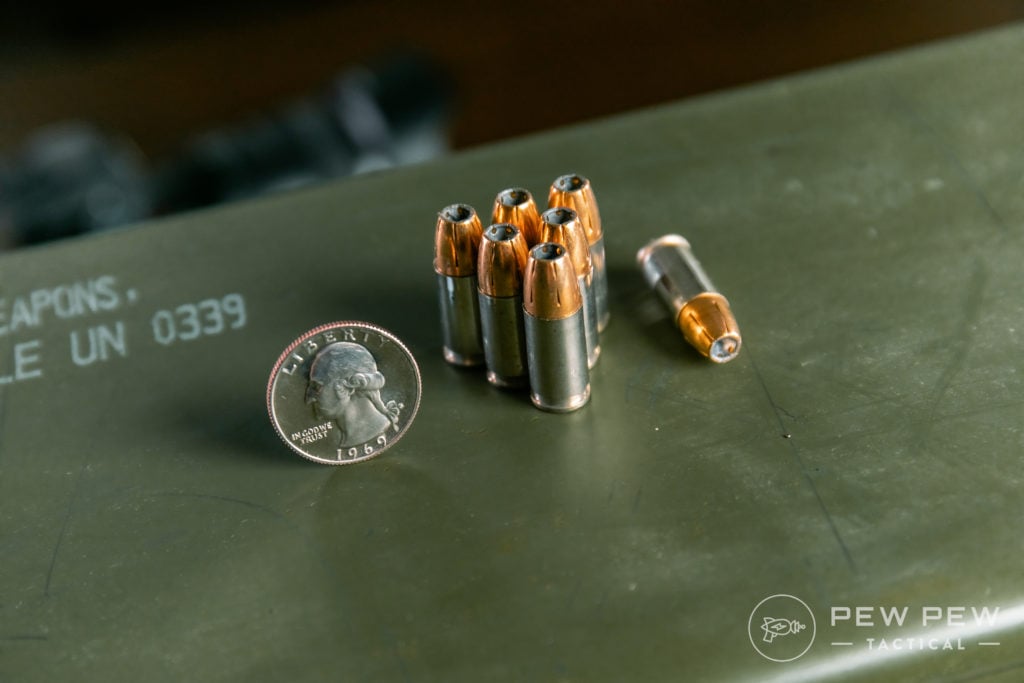
And now…there’s been a huge rise in popularity of Pistol Caliber Carbines (or PCC). Get the nice ergonomics of a rifle but with the price and hollowpoints of the 9mm.
For more info:
.40 S&W
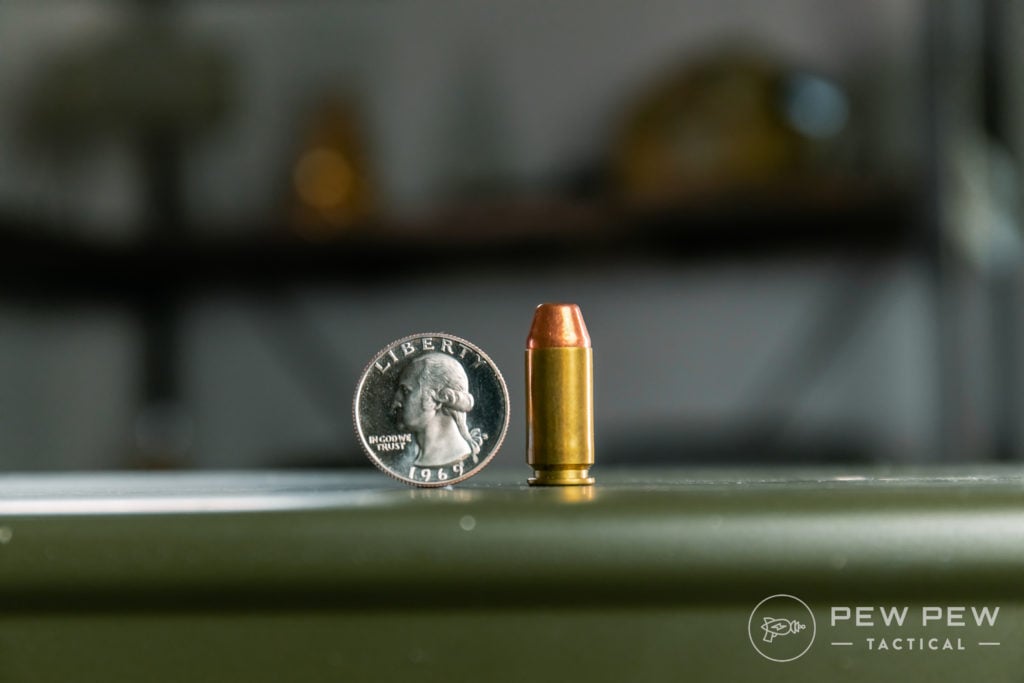
Remember how I said the 9mm was the “Goldilocks Round?” If that’s the case, then the .40 is her big, angry, whiskey-drinking sister.
Originally designed for the FBI as a reduced 10mm cartridge, and popular with other law enforcement agencies ever since. More kick when compared to the other popular handgun cartridge, the 9mm. Weights of the bullet can vary from 155 to 165 and 180 gr.
Note that the FBI recently decided to move back to the 9mm since agents are able to shoot more quickly and more accurately with 9mm compared to the .40 S&W.
For more info:
.45 ACP
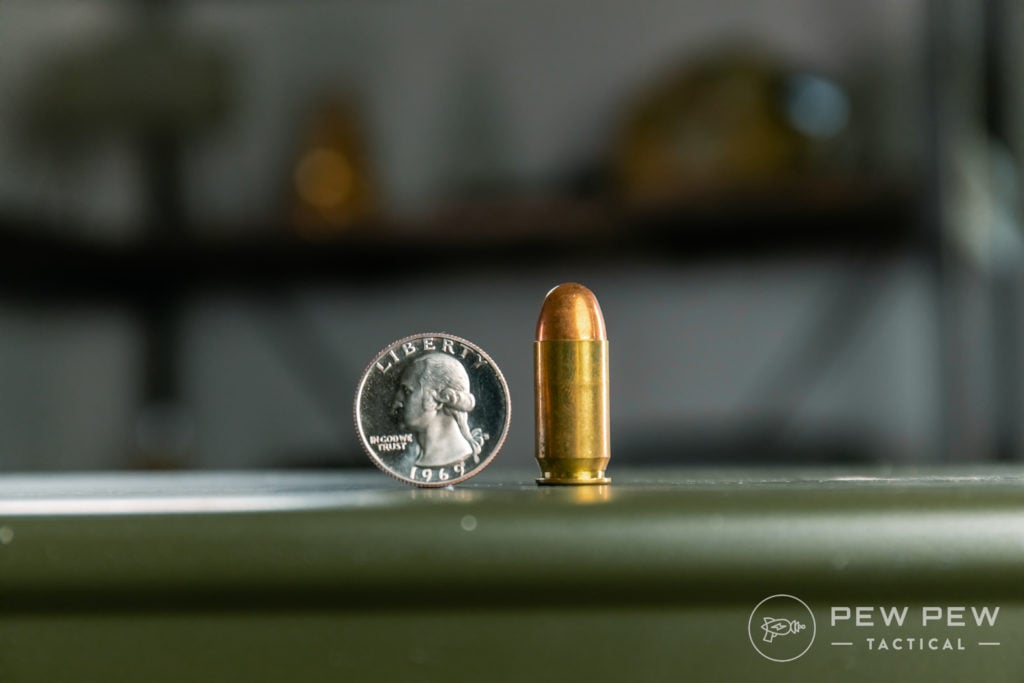
Designed in 1904 by Mr. John Browning himself for the famous 1911 pistol, this round has one heck of a history.
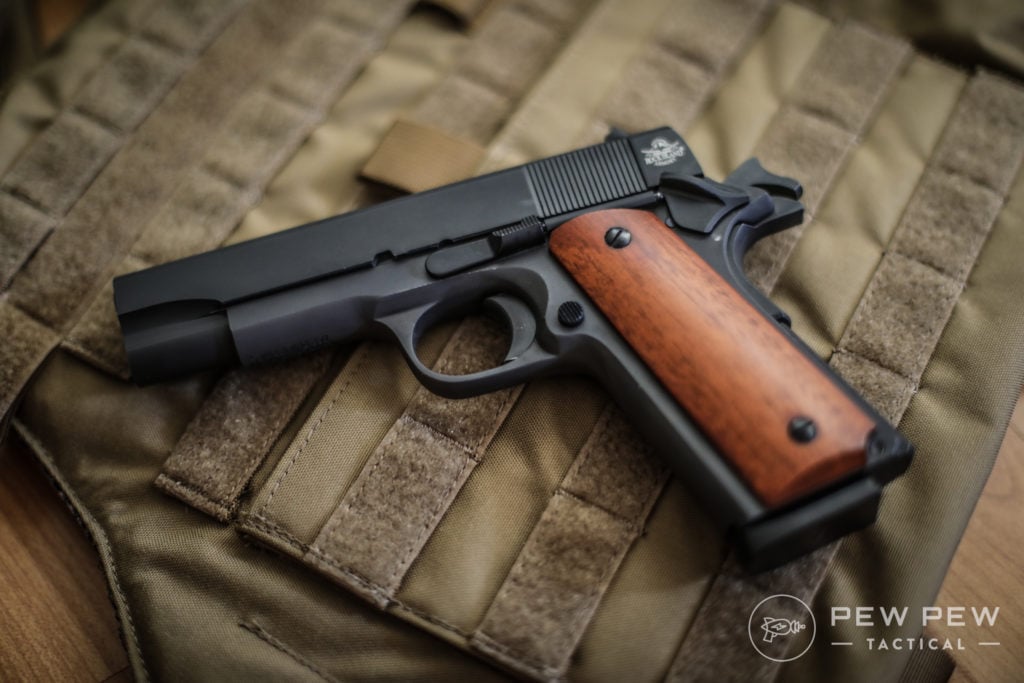
This thing is a big bullet with stopping power to spare.
The choice of many police officers and military personnel for years, the .45 caliber round has proven itself time and time again. I could probably do an entire article on just this bullet.
It has a large bullet of around 230 grains and has moderate recoil.
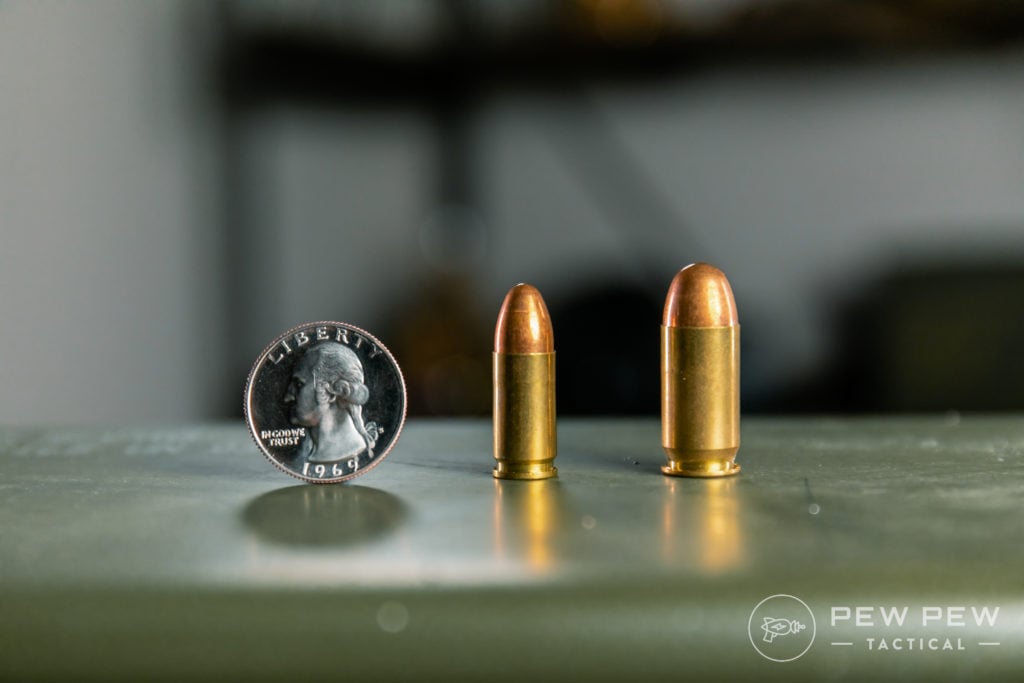
I can tell you from personal experience that this is not a round to hand to someone who’s never fired a gun before. Its stopping power is renowned and has a nostalgic following.
For more info:
.38 Special & .357 Magnum
The “thirty-eight special” is most commonly found in revolvers.
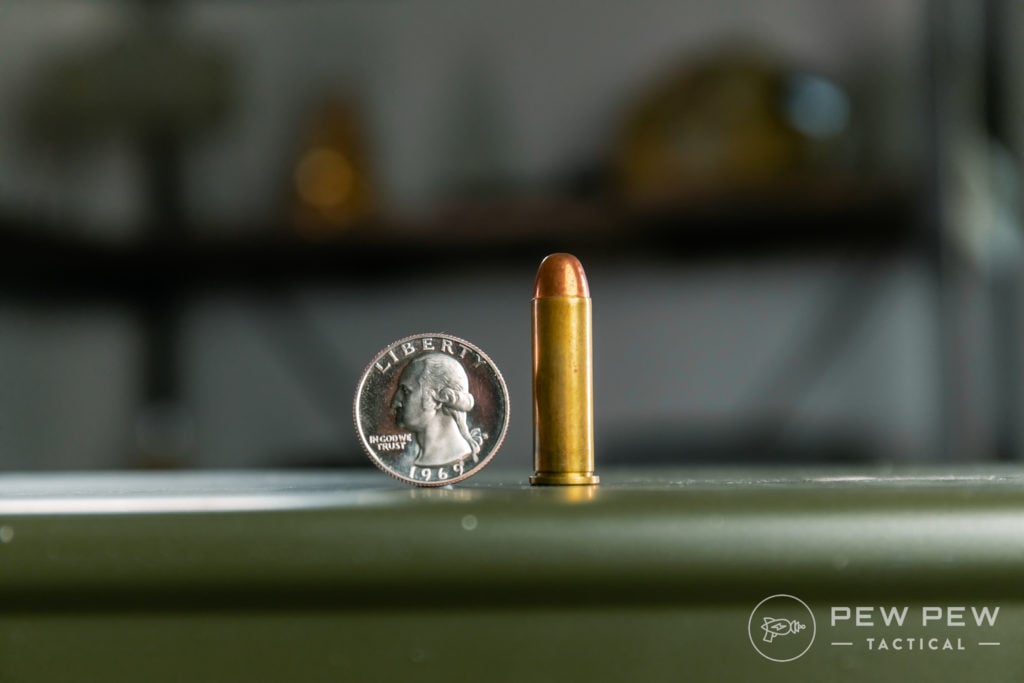
It has manageable recoil but is still quite a handful when in a very light/small revolver. It has a longer cartridge and more powder in said cartridge, but it is a slower, heavier bullet than the 9mm.
The FBI used this cartridge as its standard issue for a very long time.
The .357 Magnum is identical to the round except for being slightly longer.
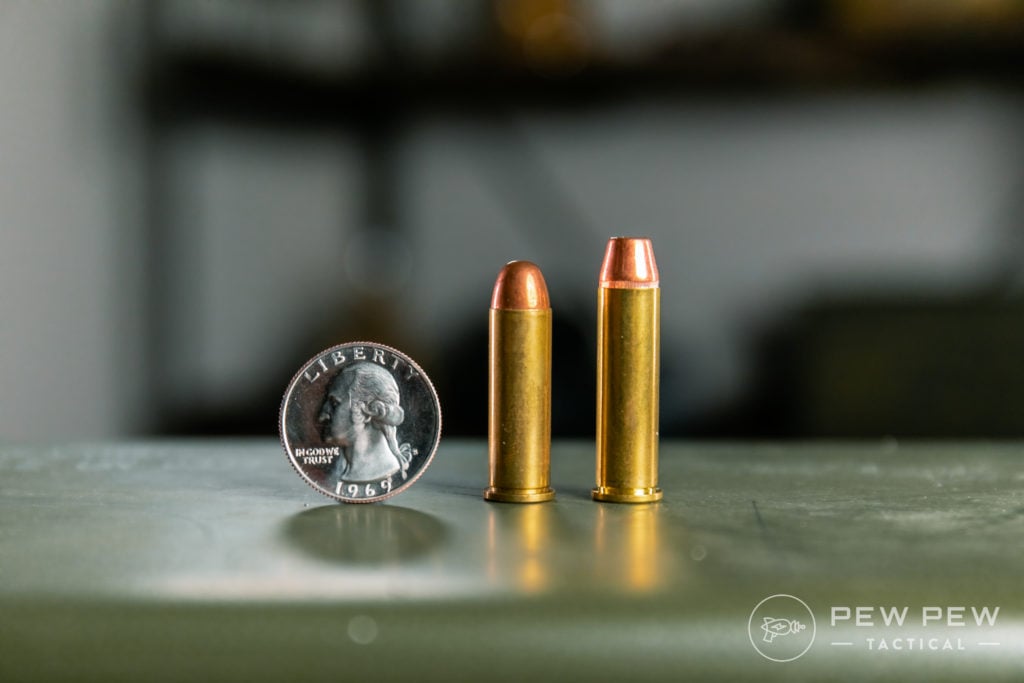
You can safely fire a .38 Special in a .357 Magnum gun, but don’t try the other way around due to size and pressure constraints.
Bullet weights vary from 110 to 132 to 158 grains.
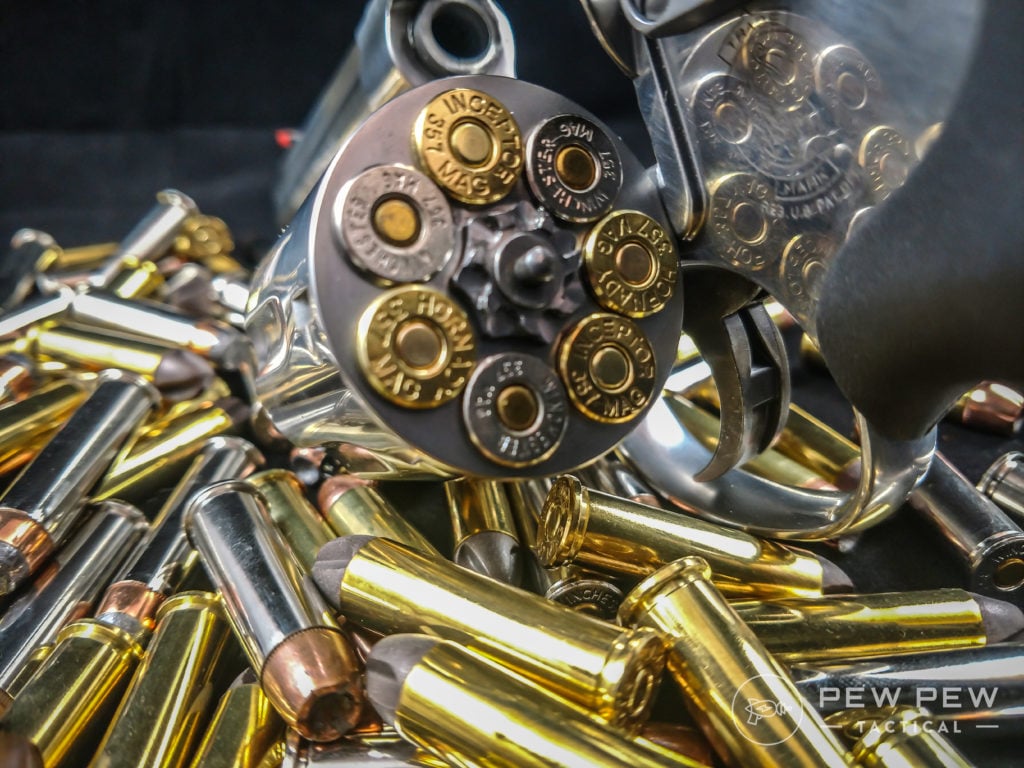
For more info:
7.62x39mm
This is the Soviet round used in the AK-47 line of rifles.
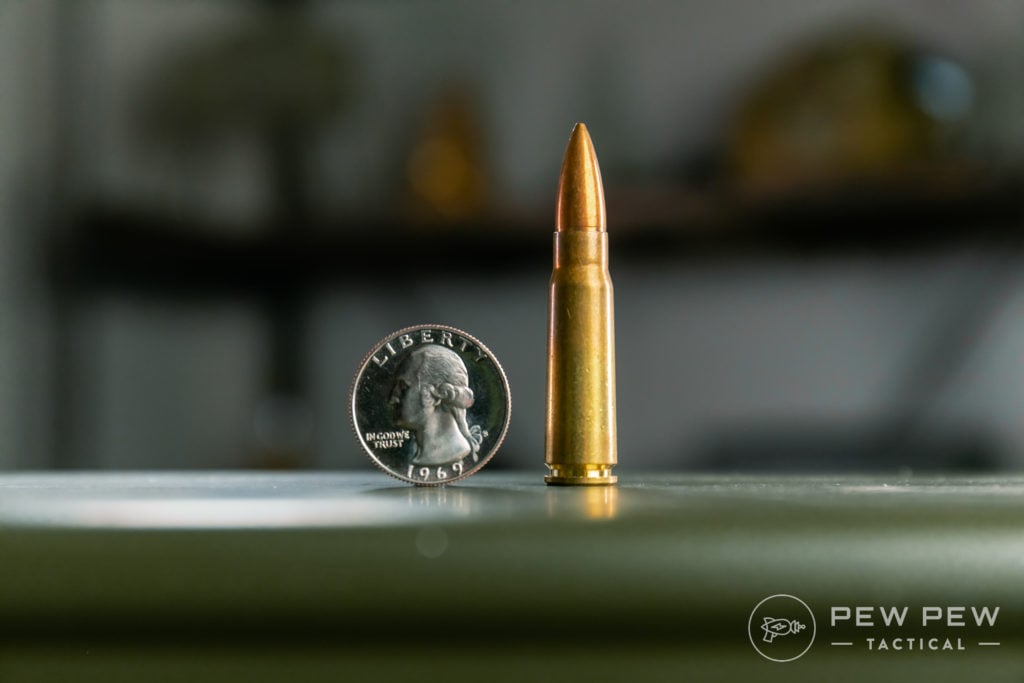
It has moderate recoil, great knockdown power, and a bullet weight of usually 123 grains.
There is a high availability of military surplus ammo which makes the round very affordable. Plus, check out its bullet size vs the 5.56 coming up next…
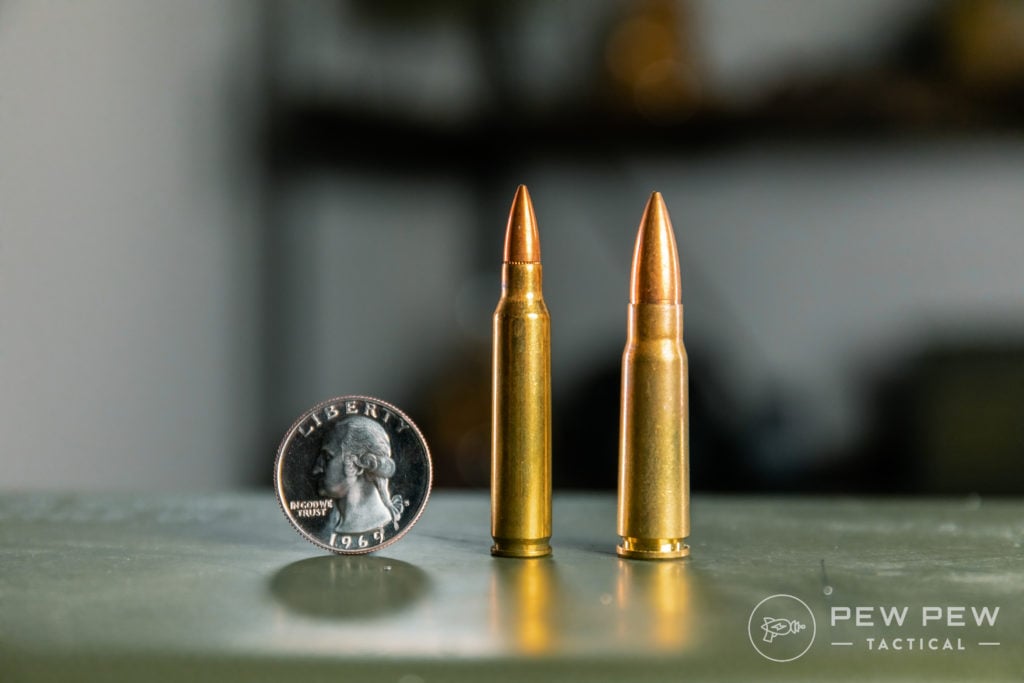
For more info:
.223 / 5.56x45mm
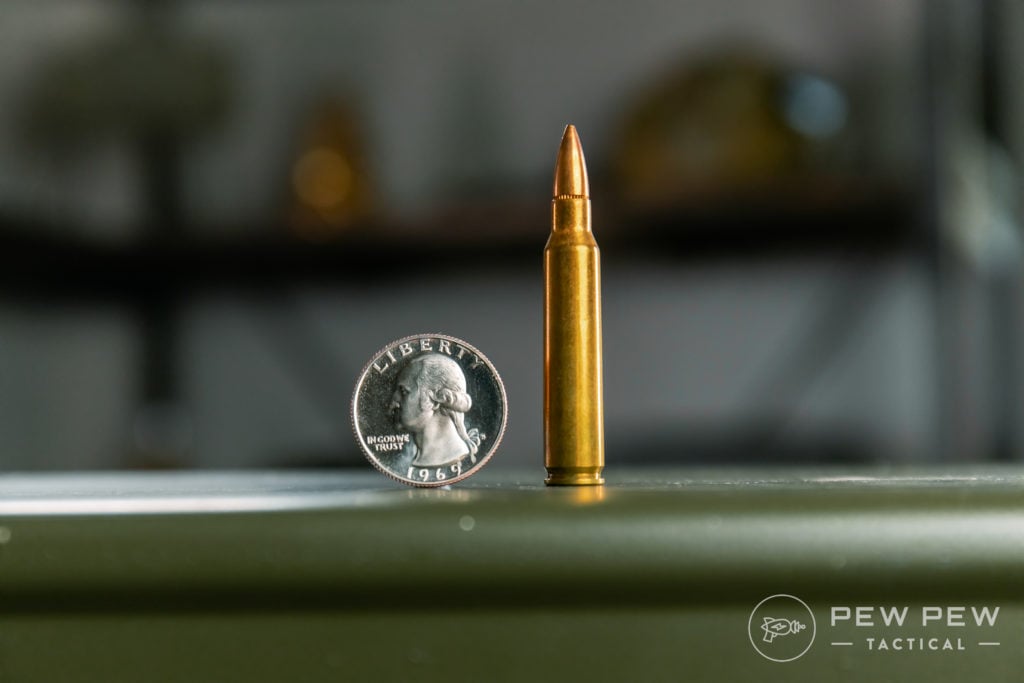
The “two-two-three” (inch) Remington has almost the exact dimensions as the “five-five-six” (mm) NATO cartridge.
The 5.56 has higher pressures than the .223, so .223 rounds can be fired in a 5.56 rifle, while 5.56 rounds should not be fired in a .223 rifle.
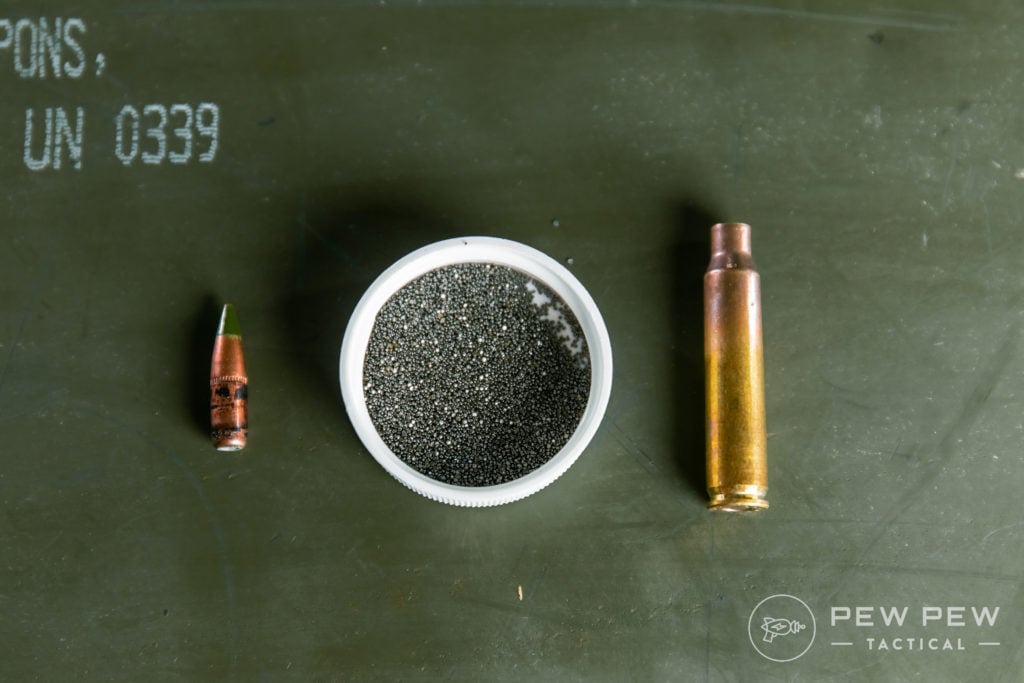
Bullets are around 55 grains, and the cartridge has light recoil.
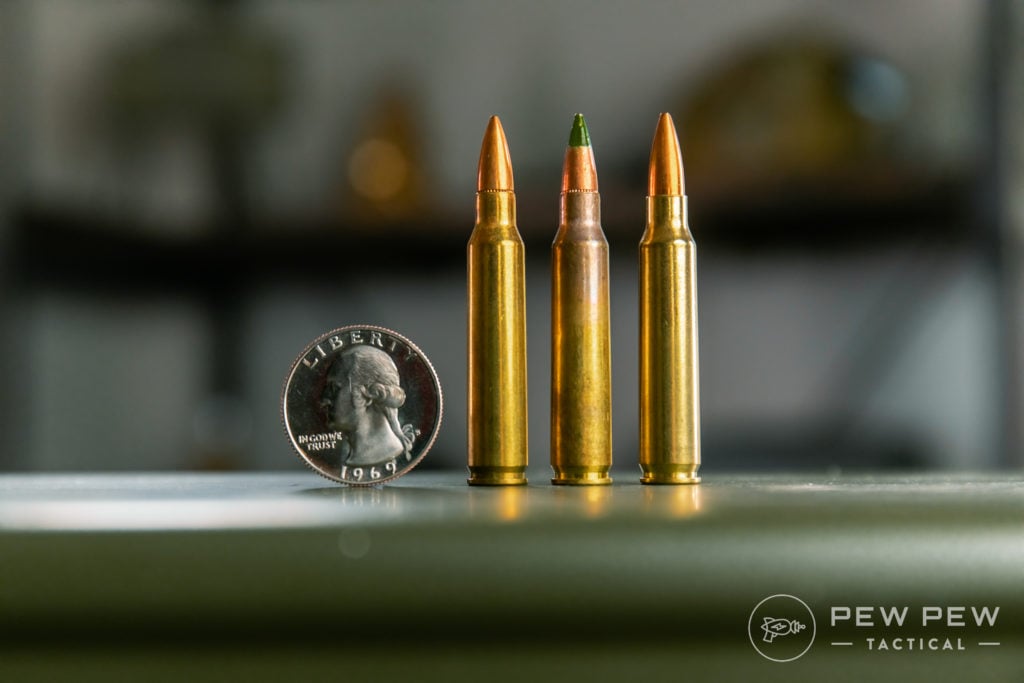
It is the ammunition used in the M16/M4/AR-15 line of rifles, and there’s still endless debate on its effectiveness in combat.
For more info:
.308 / 7.62x51mm
The “three-oh-eight” (inch) Winchester is almost the same dimensions as the “seven-six-two” (mm) NATO round.
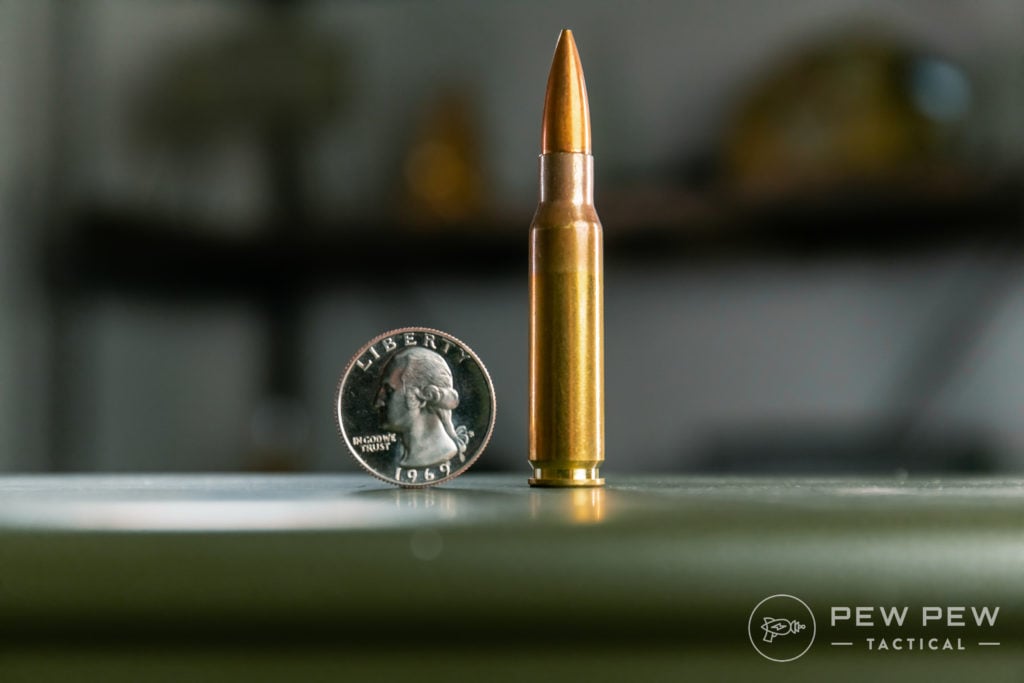
There are special considerations when mixing the rounds, but unless you know what you are doing, stick with the round intended for your rifle.
It is a popular hunting round with moderate recoil, high stopping power, and a wide range of bullets available from 150 to 208 grains.
Plus…one of the most popular heavier caliber machine gun and sniper rounds for many militaries around the world.
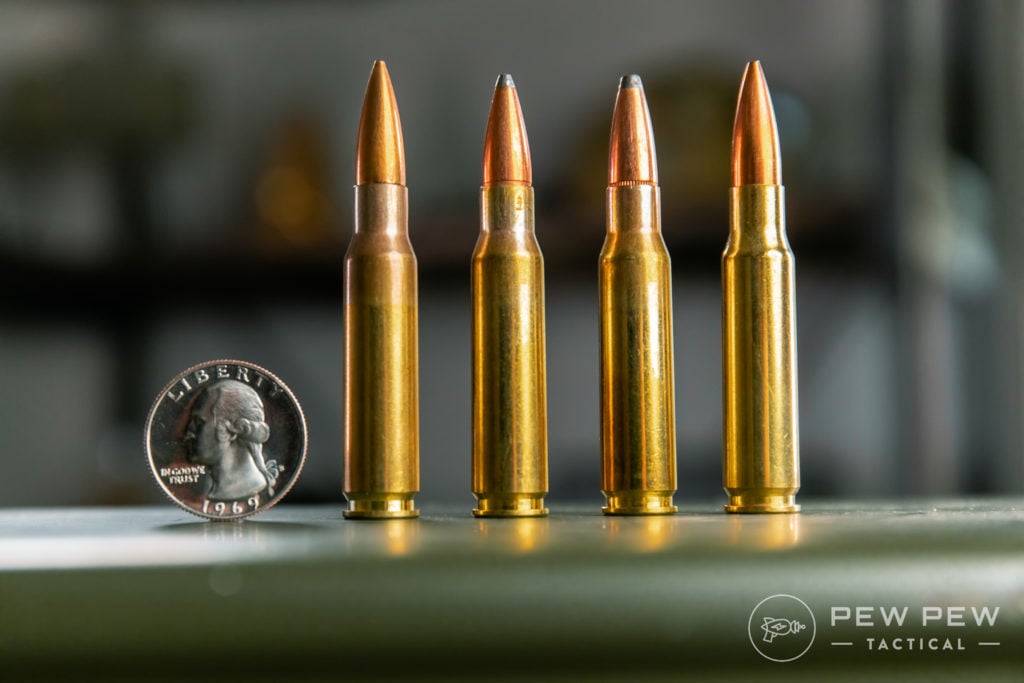
For more info:
.50 BMG
Not really common for civilians, but I just had to have it in here.
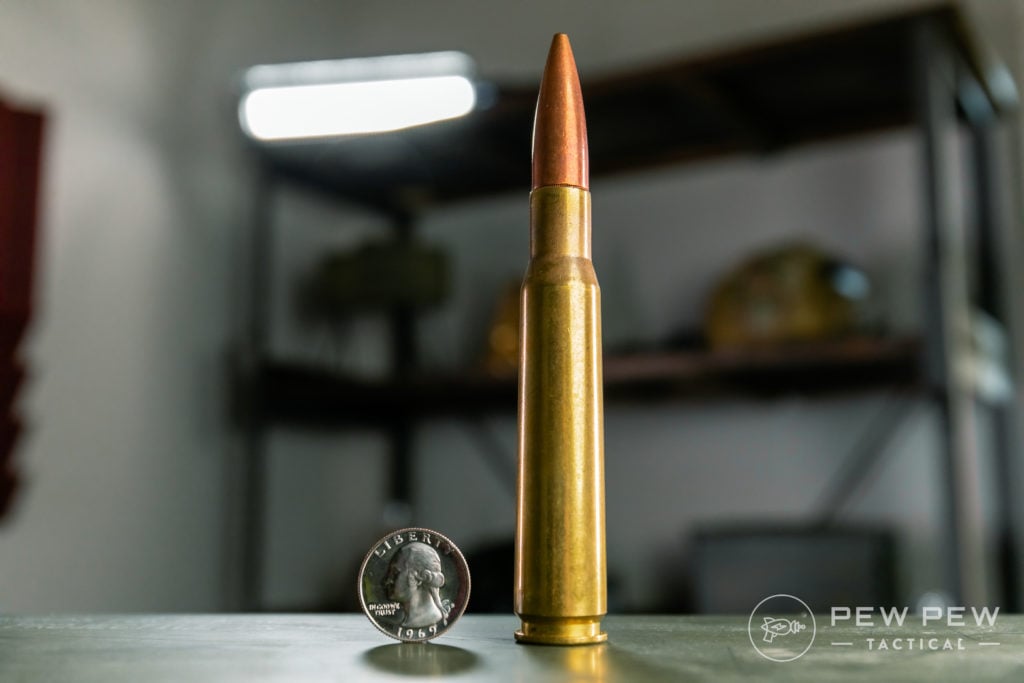
It’s huge and has huge recoil with awesome range (confirmed kills at 2,000m+), and you definitely don’t want to be on the receiving end of the bullet. 660-grains of pure stopping power.
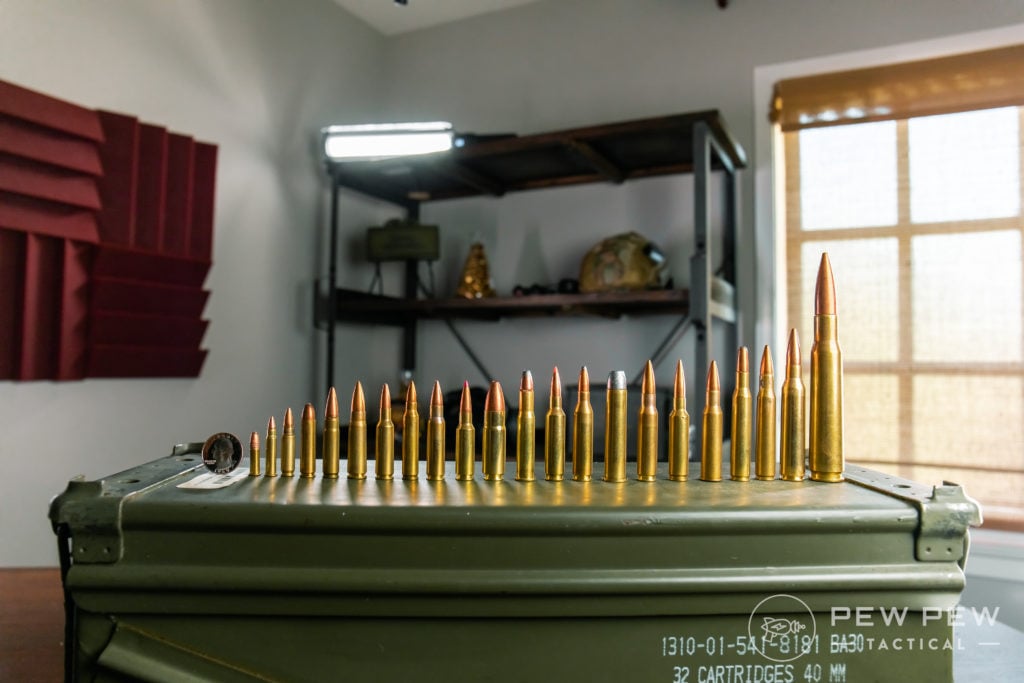
This Barrett was OK because I was standing, and it had a suppressor!
Still with me?
Common Bullet Types & Terminology
Full Metal Jacket (FMJ)
This is the most common type of bullet and consists of a soft metal core, such as lead fully encapsulated by a harder metal, such as copper.
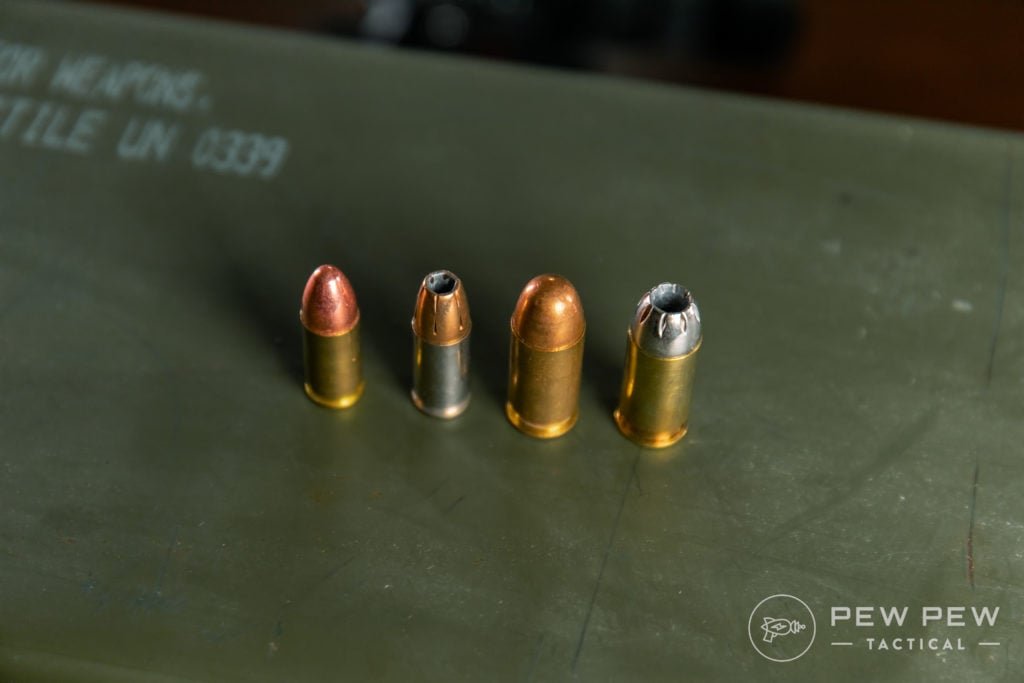
They are usually pointy, round, or even flat. Wound channels are typically small and go through a target.
Great for the range but not preferred for defensive rounds.
Hollow Point (HP)
Hollow points are made to expand once they hit something. They are the go-to round for police officers, concealed weapon carriers, and home defense guns because of their stopping power.

Open Tip (OTM)
Open-tip bullets look like hollow points since they have an opening at the top, but this is more because of their manufacturing process. The openings are too small to expand effectively.

Regular FMJ’s are created from small copper cups where the bottom of the cup becomes the tip of the bullet. Open-tip bullets are the opposite, with the bottom of the cup becoming the bottom of the bullet.
Open-tip bullets are sometimes also known as Open Tip Match (OTM) since they are preferred by long-distance shooters. The manufacturing process for open tip bullets creates a more consistent round than FMJ. Important when you’re shooting hundreds of yards!
Ballistic Tip
This is what you get when you combine the aerodynamics of an FMJ with the stopping power of a hollow point. This is a hollow point covered with (usually red) plastic to mimic the profile of an FMJ.
They are mostly used in hunting or precision shooting.
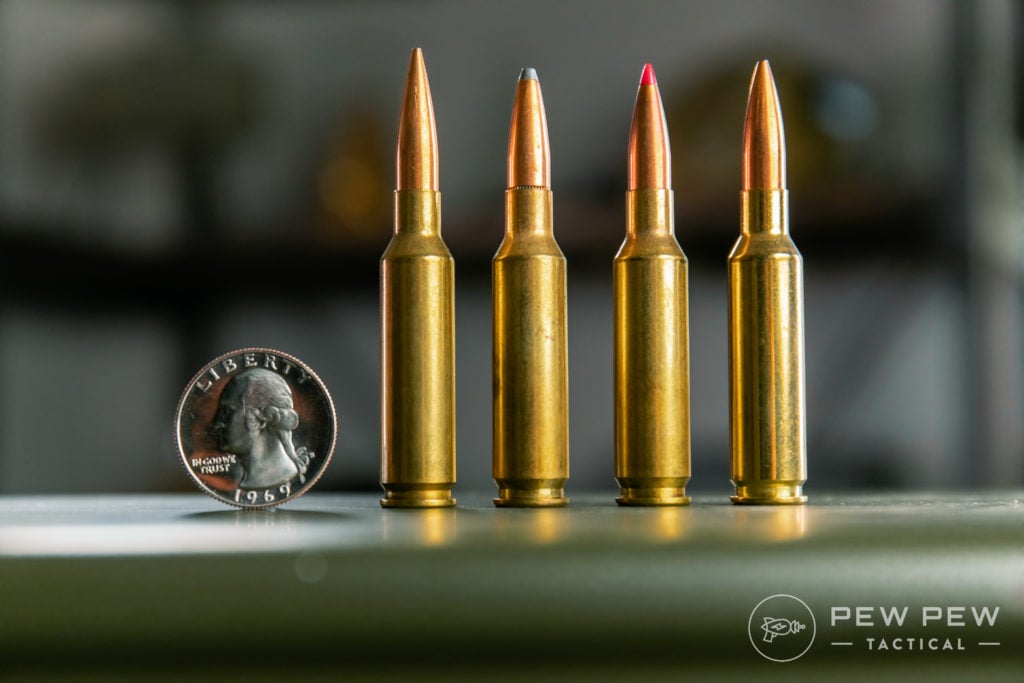
Below you’ll see that the bottoms of the bullets are more streamlined. This design is called “boat tail” and produces less drag as the bullet flies through the air. HPBT is short for “hollow point boat tail.”
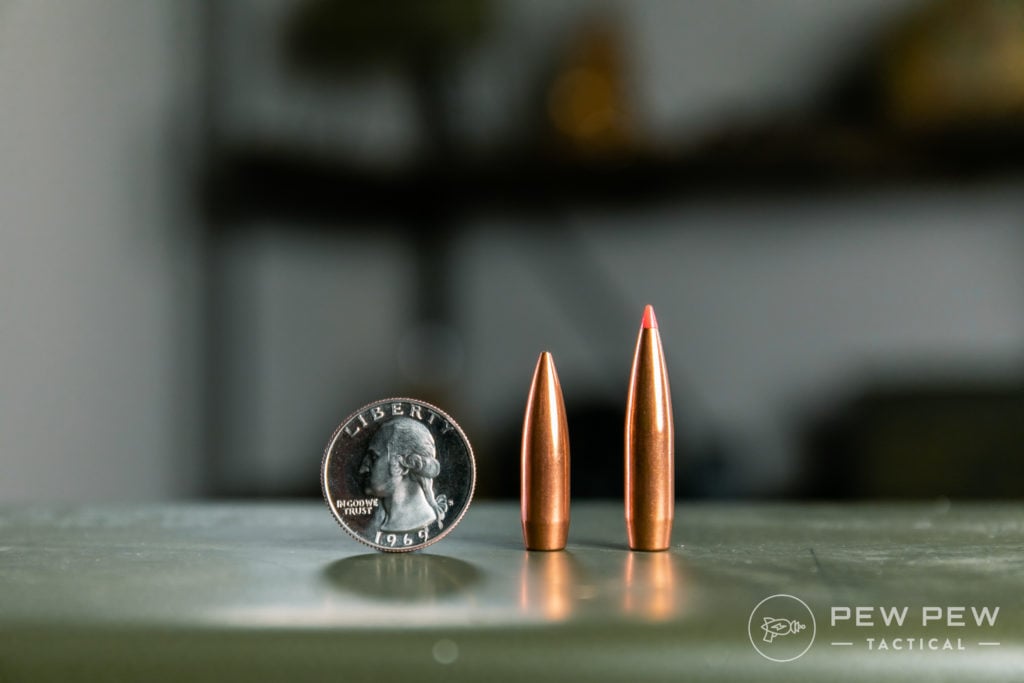
Soft Point
This is an earlier attempt to get the ballistic advantages of an FMJ with better expansion.
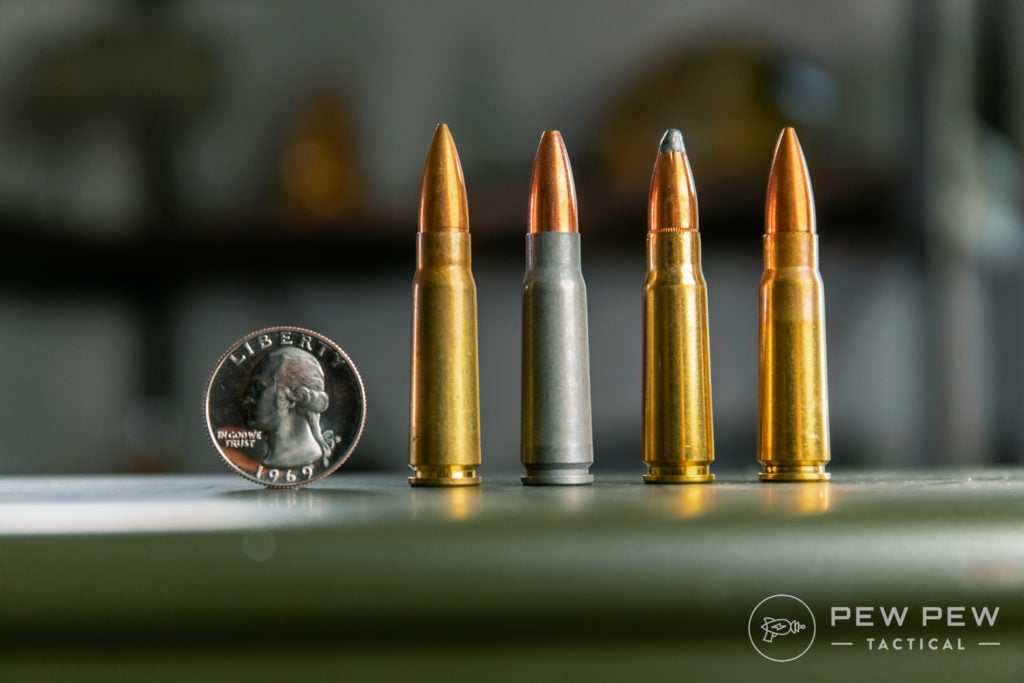
In soft point bullets, part of the lead is exposed at the tip. The softer lead is designed to flatten better when the bullet hits a target. But for the most part, ballistic tips have surpassed the performance of soft points.
Shotguns
The most popular sized shotgun round is the 12 gauge.
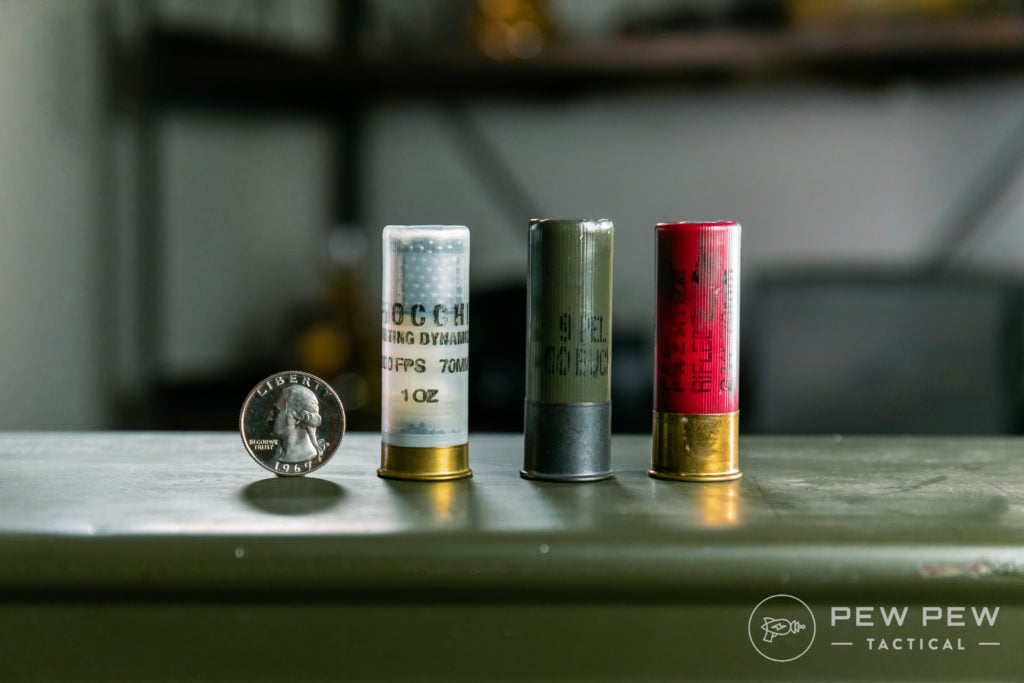
Recoil can vary from moderate to high based on round.
Shotgun ammunition is the most versatile, with three main types of loads.
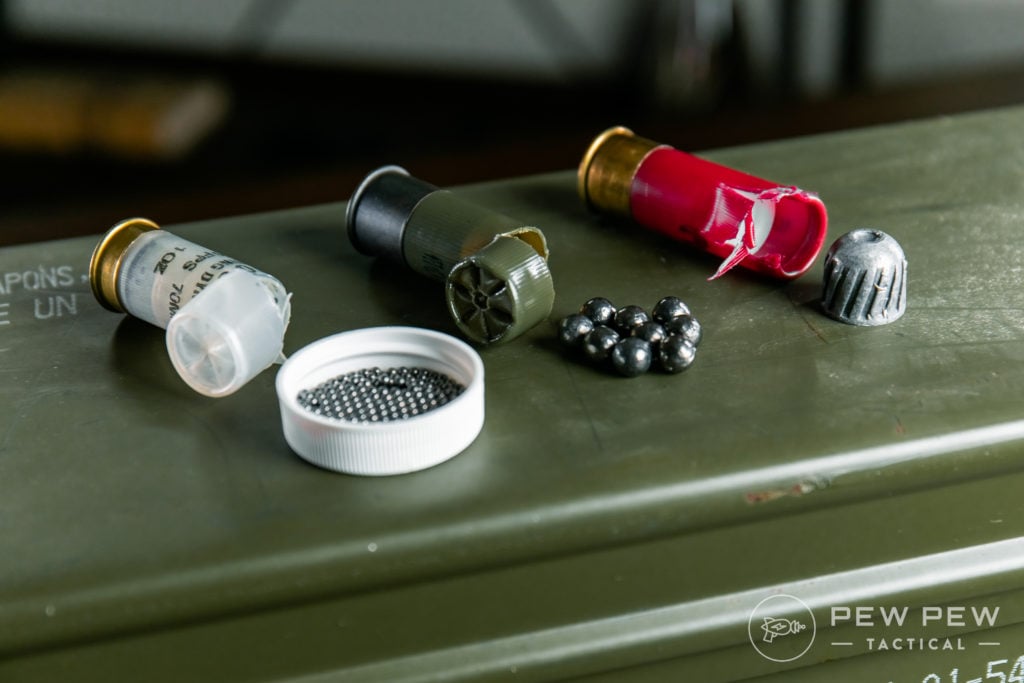
Bird Shot
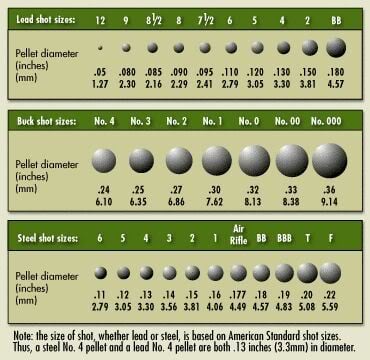
Birdshot consists of the top row and is pretty small pellets numbering in the dozens in each shell.
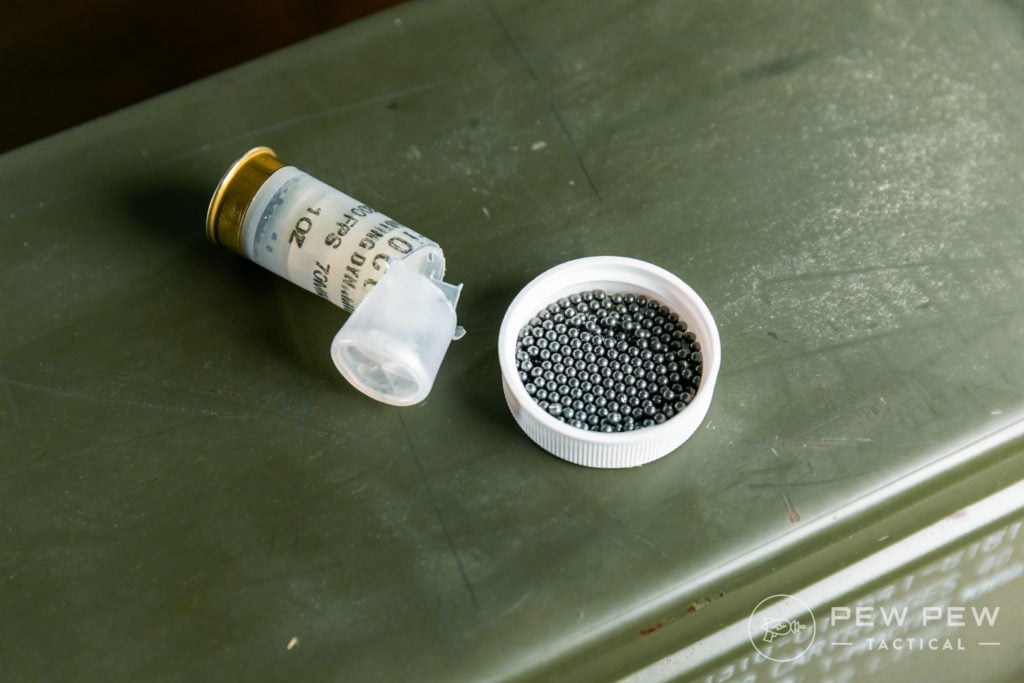
Great for hunting birds and blasting clay pigeons but not the best for home defense.
Ok recoil.
Buck Shot
The overall best home defense round is buckshot. 00 (“double-aught”) is the go-to load.
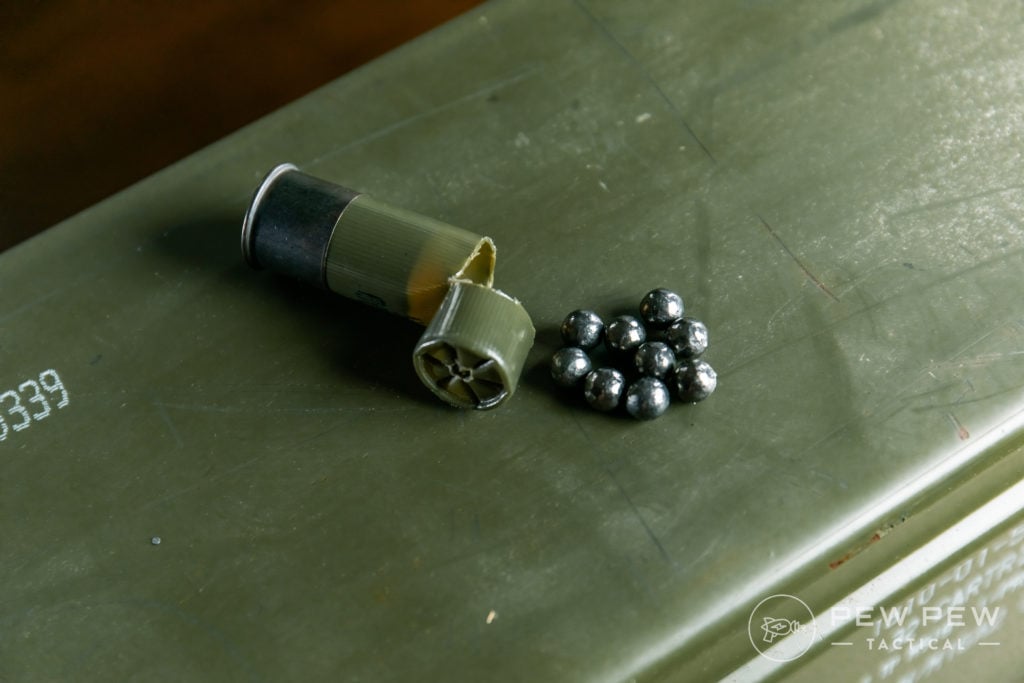
It’s nine solid lead balls the same diameter as the 9mm handgun bullet.
Much more recoil usually…but you can also find reduced-recoil buckshot rounds too.
Slugs
Slugs are single projectiles that are around 1 ounce of solid metal that really bring the hurt.
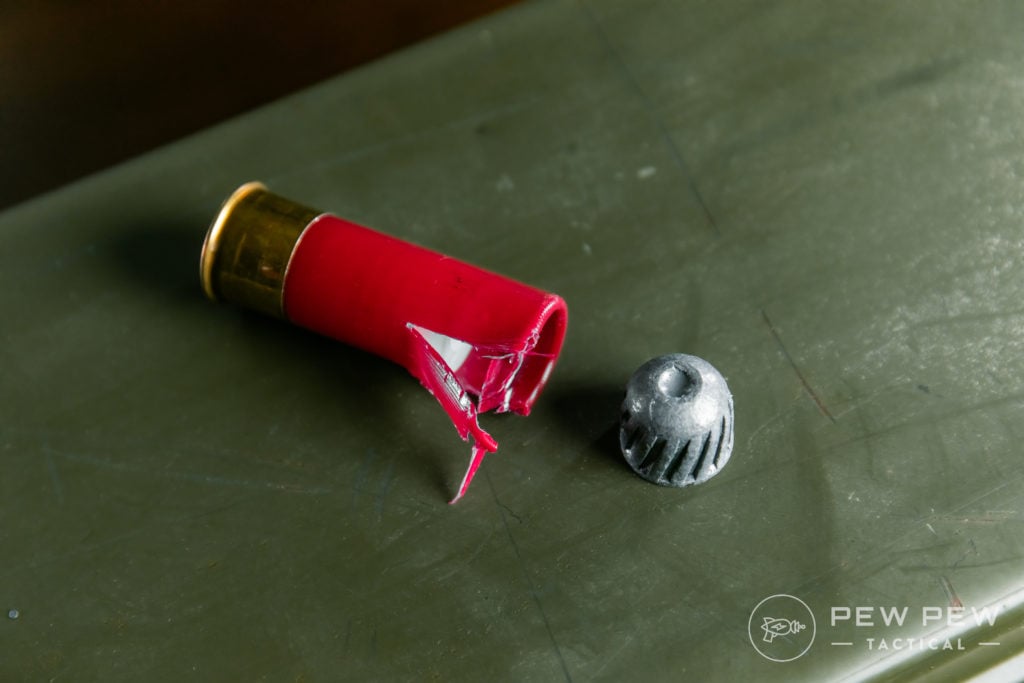
However, they don’t have the spread of birdshot or buckshot. But, in the hands of a solid shooter, they can be accurate up to 100 yards.
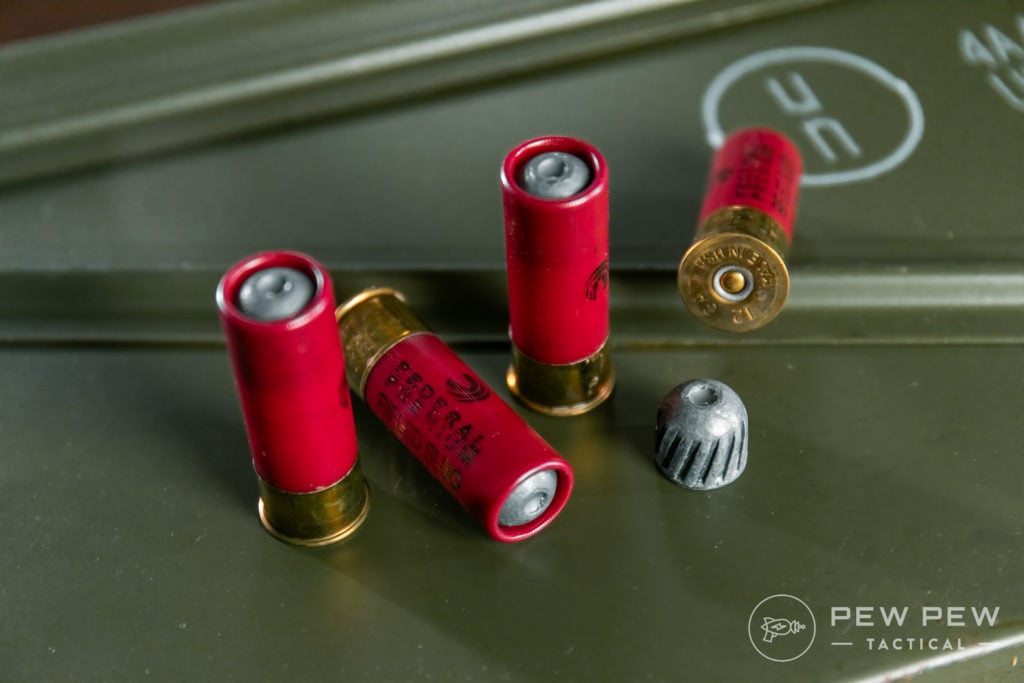
For more info:
Components of Common Cartridges
What makes up a cartridge?
Here are just a couple of breakdowns of super popular calibers. You can see the difference in powders & bullets for each type.
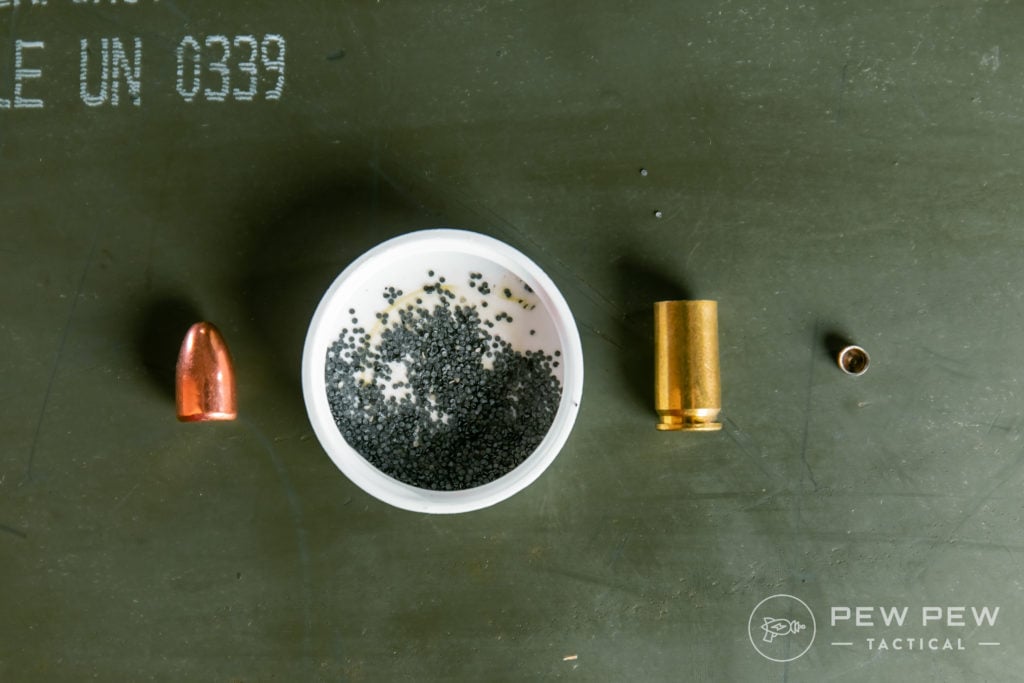

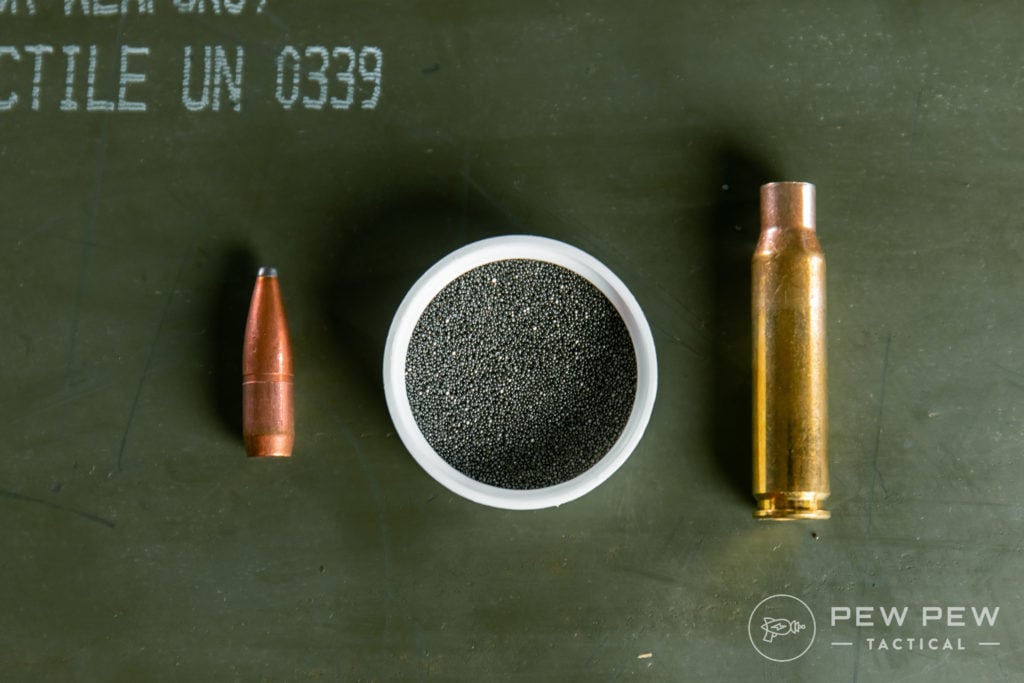
Final Thoughts
There you have it…now you’re a bullet pro!
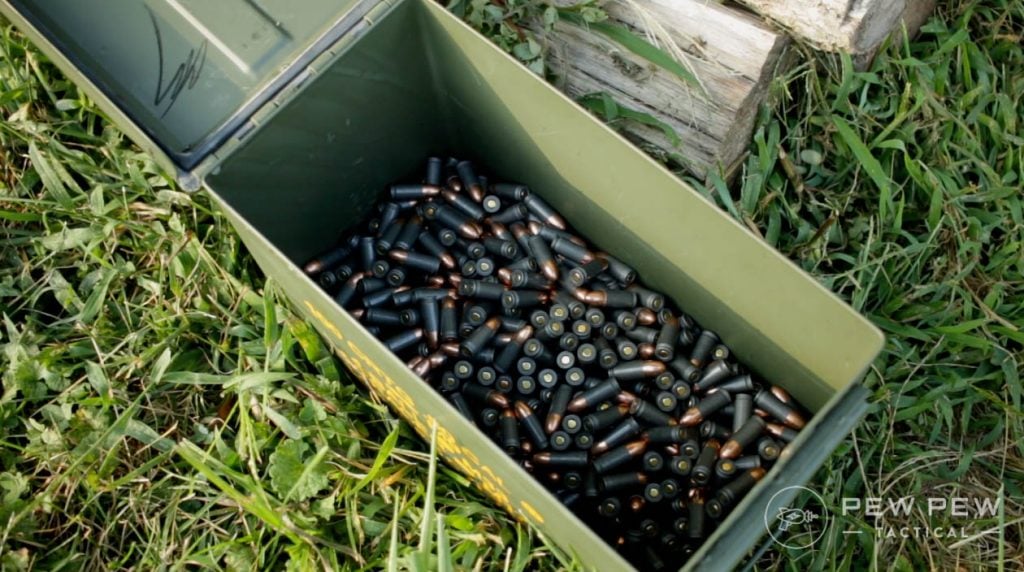
Continue on with a deeper dive into Popular Handgun Calibers, Popular Rifle Calibers, or the difference between Steel Cased and Brass Ammo…or head on over to see where to buy some Ammo Online.
And if an expertly created beginner handgun course is what you’re looking for…check out Gun Noob to Gun Slinger.

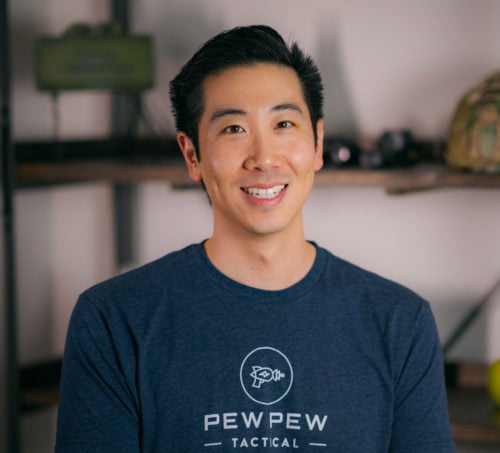

242 Leave a Reply
This was a really great read very informative!
Great collection of info!
How about adding small weapons like the baby browning, star,’ weapons that fit in your pocket are very useful. Small gun Big surprise.
Is there a reason why you didn't discuss the 10mm? Since it was developed specifically for the FBI, but then discontinued due to agents being unable to handle the power of the recoil.
It was not the recoil that was the problem; it was the ballistics pertaining to accuracy and the female agents with a smaller grip. The 40/10mm ballistics are ok but not good or great. The second, most ladies have a smaller grip range and the 40/10mm frame was not friendly to smaller hands. The 9mm has much better ballistics, accuracy, lighter recoil, and a smaller hand grip. These are the main two reasons the FBI moved back to the 9mm.
That's a lot of great information.
I might add, for 100+% larger wound cavity than HP defensive, or hunting ammo; UnderwoodAmmo offers the best there is, making it possible for those who need to go with small calibers/firearms; still remain effective.
Nice work, Eric. Even as experienced shooters, we can all use a review on this information from time to time. I definitely learned some things from this piece.
Great article, touching the key points, could be nice to have muzzle brake and sound supressor included in other blogs. Guns and ammo for hunting is my primary interests. Thanks Eric.
One thing you missed Eric. John M. Browning didn't just develop the .45 ACP, but he also developed the .25, .32, and .380 ACP cartridges (though the .25 and .32 didn't make the list). Ol' John developed the .50 BMG as well.
You've a good animated diagram of Boxer v Berdan v Rimfire Priming Systems, but you didn't point out the difference between Boxer and Berdan primers. Boxer: Single Flash Hole, Anvil in the Primer Cup. Berdan: Twin Flash Holes, Anvil in the cartridge case, and that Boxer primed cases can be reloaded, Berdan primed cases are not (or not without some real specialty tools).
Just a couple of items for your primer worthy of mentioning.
I wonder where 6.35mm Beretta and 7,62 James Bond ammo fit in the handgun bullet table. They are clearly missing.
.38 special, .357 mag NOT the me as 9mm! 9mm is typically .355-.356 inch diameter. .38/.357 is typically .357-.358 diameter. (jacketed v cast lead) Not a big deal in some loads but it is in others. I've been reloading for more than 60 years!
Yep. You're right. They're real close, but swapping one into the other can and will effect accuracy and potentially change the pressure curve as the slightly bigger bullet is forced out of the barrel slighy smaller than the bullet..
Great job on this article. Very informative and well written so anyone can understand. I am disappointed by but expected the kick back from the people that use weird or useless calibers. We must all remember this is an article not a book. It covered the basics and most popular calibers which helps people learn. Well done.
Truly a remarkable volume of info. The pix really help put things in perspective.
A very solid article indeed of the most common calibers, but so much easier to follow and learn. Outstanding explanations. Guns matter little without knowledge of ballistics, and this lays the groundwork for so much. Thanks! 30-06, 300 blackout, 10mm are full of rich stories too...for sure, but history is less important than the bullets, and bullets lay the ground for picking ballistics.
sorry don't see anything I use listed except 22LR
My CCW pistol is 44-40, rifles are 30-06 and 30-30
missing the ol work horse 3006 , 303 brit and 6.5x55 swede all great rounds
NO mention of the 38 super? A .356 bullet with a history of competition shooting. This cartridge will out shoot the popular 9mm. It requires a barrel, magazine change
I'm back to shooting after many years and due to moving I can now purchase pistols. Truth, I did not follow evolving laws. I'm not even sure my pellet pistols were STILL legal. Well done article. I suppose using your links people can look up the costs. I own a 380, ammo is hard to find and costs more than the 9mm. I also find it is more likely to jamb in a pistol. Not truly
qualified to say this with authority. The 9mm at 15-17 rounds. That is true where I live. Some states the limit is 10. I just purchased a 357mag revolver. The cost of ammo, frankly can break the bank and right now hard to find.
Eric, regarding jacketed bullet diameter for .380, 9mm and 38 Special, to be clear, they are not all the same as stated in the article. The .380 and 9mm are the same at 0.355" and .38 Special is 0.357" same as 357 mag.. Two thousandths of an inch does not sound like much but it could lead to a serious problem using a 38 bullet in a .380 or 9mm resulting in a serious pressure spike. In addition using the smaller 9mm bullet in 38 Special will not engage the rifling and accuracy would surely suffer.
A Wonderful guide!!
Tim
Thank you, I didn't learn everything but this was introductory. I have a shotgun, 40 Sig, and 20 aught 6. And I never understood bullets. About to get my first Carbine and didn't understand price differences. You helped a lot. Still want my Barrett, I shot it maybe 15 times as the Corpsman on Marine ranges. When you shoot a .50 cal I want it always. Do you talk about silencers? But thank you! I just grew up hunting deer/elk in Oregon as a kid, a little bird. But I loved stalking deer, not like lazy Texas hunters.
Re: 50 cal
We've all read about the warthog. If, I recall it is 6000 rounds per sec. The 50 cal shells are last time I looked- $1.50 each.
Not the first time in history. Interesting, Custer at the battle of the little big horn his troops were armed with trapdoor Springfields a single shot weapon. Some of the Indians had lever action Winchesters.
THIS IS GOOD STUFF!!!!!!! Thanks for the information and pics. I learned so much.
Excellent, went from knowing nothing to a head full of facts to sink in. Thank you for the concise and clear descriptions.
İ have empty luger (mm9)buletts
Wow!
excellent/
thank you
30-06 was omitted and that's too bad... Outstanding hunting cartridge and the one (in the M1 Garand) that helped end WWII in Europe. Flat shooting and stopping power!
This is very knowable on ammo size and for best results love the article.
Great information put together in great order and clarity
My father has been reloading for 35 years and even with the scarcity of bullets reloading hasn’t been an option. Primers and bullets are hard to get or ridiculously expensive.
Because of the cost of cartridges I am thinking of getting into reloading. I have noticed that casing come in brass and steel and probably other types. If I am going to reload is there a better type one casing over another?
use brass only if you want to remain sane.
Brass is best, steel can Abe reloaded as can aluminum, but it is hard on dies. Also typically you want boxer primed brass. Better ck cost and availability of powder and primers before you jump. Great hobby
Great article Eric. Many thanks.
Hi, What does ACp stand for?
Automatic Colt Pistol
Automatic Colt Pistol
Great article for a "semi-new" gun owner, soon-to-be enthusiastic. I hear folk spitting out shell types, bullet thingama sizes, etc. and I'm like, I need to learn this basic knowledge. Appreciate the break down of bullet sizes for each one of the weapons I own.
I purchased both 0.38 Special and 0.38 Superauto cartridges. I later heard the superauto will not fit into my 0.357 Mag pistol. What is the difference and please confirm they will not work.
I also purchased some 0.357 Sig and later heard it will not work in my .357 Mag pistol. Again what is the difference and please confirm they will not work.
I don't know the exact dimensional differences, for that you could google their Wikipedia pages. It is correct though that .38 Superauto and .357 Sig will not in any way safely fit in a .357 Magnum pistol. Only .38 Special and .357 Magnum should ever be used in a .357 Magnum gun.
Thank you for the info, I appreciate your time
Well done, very useful.
I need a description of the metric rounds. For example, what does 7.62 X51mm stand for?
7.62x51 is generally .308 Winchester, although the NATO specs and the .308 Win spics are slightly different they are mostly interchangeable with modern rifles.
10mm for bear country!
My wife carries a Walther P-22 loaded with CCI stingers, want to get shot with that pellet gun?
What about the 300 blk